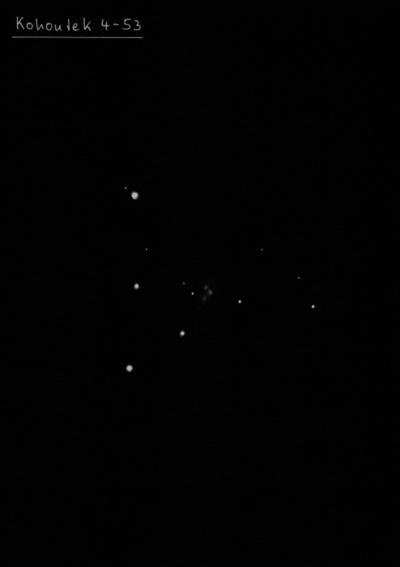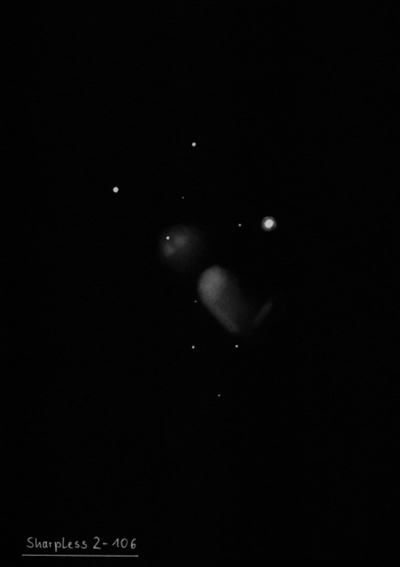The most prominent summer constellation of the richest region of the Milky Way in the Northern Hemisphere. The constellation is very striking and is sometimes called the Northern Cross because of its shape (it is made up of stars, the centre of which is marked by the star γ Cygni, with the star Deneb at the apex and the famous double star Albireo at the base. When the Swan is in the east, the cross lies on the left side. Only as it moves westward, sometime around Christmas, does the cross gradually rise. The constellation includes a large number of individual objects, both pretty to look at and astronomically interesting. Among the binaries, Albireo and 61 Cygni are particularly well known, the North American emission nebula, which with luck can be detected in small binocular, and above all the jewel of the whole sky, the Algal Nebula, which, together with the Crab Nebula, is the best observable remnant of a supernova explosion. There are also a large number of planetary nebulae and open clusters in the constellation.
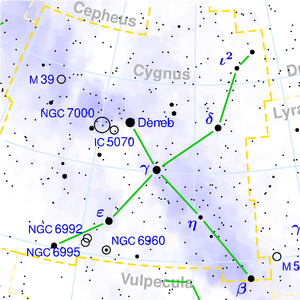
The Swan contains arguably the most visually beautiful part of the northern Milky Way. The Great Rift here, with its sharp boundaries with the starry clouds, exhibits high contrast. The most striking cloud (by far the brightest part of the Milky Way north of the celestial equator) extends in a westerly direction all the way from Albireo to the γ Cygni region and is elongated in shape. It extends about two degrees to the east of the conjunction of these two stars, and a degree farther to the west. First notice that it has a different brightness than the Cloud in the Shield - it is not as hazy and is more of a fluffy white color. In the binocular, there is a very high density of stars visible in this region. The western half of the cloud contains a very bright circular brightening around Albireo, this is the most striking formation ever in this part. The eastern half of the cloud is exceptional because of the abundant excess of stars of 6mag to 10mag brightness and there is a second brightening which includes a string of bright stars 28, 36, 40 Cygni and others. In addition, there is a system of dark nebulae throughout the cloud, the most striking of which is Fish in a Bowl (Barnard 144), in the vicinity of the star η Cygni. It takes the form of a slightly curled oval in the shape of the letter S. When we look into this region, we are actually looking along the spiral arm of our Galaxy, the Orion arm. Its edge curves toward the center in the Swan, while on the other side of the sky, in the Ship's Back and in the constellation Sail, it points away from the center.
A very interesting region is that around the star Deneb. The Great Rift ends here, the two main streams of the Milky Way join each other in a rather complicated way, and the Milky Way itself continues on with only one branch. The dark region centred roughly between Deneb and Gamma Cygni is called the Northern Coal Sack (LDN 896). To the east of it is a conspicuous star cloud that lies roughly in the region between the stars ξ, 57, 59 and 68 Cygni. It includes the well-known emission nebula North America. A long and narrow, but striking black rift cuts into the cloud from the north (from the α - η Cephei junction). It includes a very dark, oval-shaped region four to six degrees wide (Le Gentil 3), visually perhaps even darker than the sky itself, and containing not a single star visible to the naked eye. It is indeed black as coal and looks like a hole in the sky. After the Southern Cross Coal Sack and the Hadonous Pipe, it is perhaps the easiest dark nebula to observe in the sky. Yet in excellent viewing spots it does not disappear from the sky even with a ten-day-old Moon, especially if the atmosphere is so clear that scattering of moonlight in the atmosphere is minimal and there is no more light pollution.
The dark nebula continues in the form of a narrow section further on (Funnel nebula - Chimney) less distinctly, but uniformly with a constant width of one degree across the star ρ Cygni crossing the Milky Way, and at the other edge it passes smoothly into its surroundings. The optical binary ω Cygni is visible as a solitary hazy spot above Deneb. About four degrees east of Deneb, you can try to see an inconspicuous half-degree fog spot, in this case the open cluster M39, under good conditions. This is the centre of a small local brightening, located in the western half of another white star cloud. This is oblong in shape and on the other side extends to the northeastern limits of the constellation of the Lizard. It is perhaps comparable in size and brightness to the one in the western part of the Swan (there is no more conspicuous formation further out). Its brightness is uneven at first sight. The first conspicuous oval-shaped dark spot, Barnard 168 (Dark Cigar), in which no stars are visible to the naked eye, is four degrees slightly southeast just off M39. It has sharp edges and contrasts with its surroundings - a truly vast cloud of dusty material that prevents us from seeing into the more distant parts of the Galaxy.
Deneb (α Cygni) - The brightest star of the constellation, which, together with Vega in Lyra to the west and Altair in Aquila to the south, forms the Summer Triangle. This bright blue-white supergiant (1.2 mag) is much farther away than other bright stars in our sky - it is located at a distance of 2600 light-years. In order for Deneb to be so bright from this distance, it must have a greater energy output than 60,000 Suns, making it one of the most luminous stars visible to the naked eye (for example, Vega is 25 light-years away from us and Altair is only 11 light-years away). Its mass is 19 times that of the Sun and its diameter is 203 times larger. The surface temperature reaches 8500K.
Sadr (γ Cygni) - The star has a companion with a magnitude of 9.9 at a separation of 142" that can be seen using a telescope with a 6 cm diameter objective. It itself is also a close binary star. Its distance from Earth is estimated to be 1800 light-years, so its luminosity is therefore 33,000 times greater than that of the Sun.
δ Cygni - Binary star, with component magnitudes reaching values of 2.9 and 6.3, their separation is 2.4" and the distance from Earth is 124 light-years. It is a good test for a 10-15 cm telescope. The primary component is reported by observers as white, pale blue, or even blue-green, while the secondary appears pale blue to blue.
Albireo (β Cygni) - It forms the head of the Swan or the bottom of the Cross and is one of the most beautiful contrasting double stars. Because it is not possible to directly observe the weaker star orbiting the brighter one, it cannot be said with certainty that it is a physical double star. The system is approximately 400 light-years away. The primary component is 950 times and the secondary component is 230 times brighter than the Sun.
χ Cygni - At its maximum of 3rd to 5th magnitude, this long-period variable star is located in the southwest part of the constellation visible to the naked eye, while in 6 to 7 months or up to 406 days it reaches a minimum around 13th to 14th magnitude. After the Mira Ceti itself, it is the brightest star of this type. A suitable comparison star is η Cygni (3.89 mag).
61 Cygni - The inconspicuous binary star, distinguishable even with a smaller telescope, is known for being the first one to have its trigonometric parallax measured in 1838 - the distance of this celestial object was determined by the German astronomer Friedrich Wilhelm Bessel (who mainly worked in astrometry - he accurately measured the positions of over 50,000 stars and based on the analysis of their irregular proper motions, he predicted the presence of their long-invisible companions for both Sirius and Procyon in 1844).
Cygnus X-1 - A binary star near η Cygni. It is a variable source of X-ray radiation. One component is visible, the other is not visible, but X-rays are emitted from its surroundings. The visible star is a luminous giant, the invisible component is likely a collapsed old star with a large mass - a black hole with a radius of only 10 km, which draws a huge amount of gas from the luminous giant (with a radius of 10 million km) and emits extremely intense X-ray radiation before it reaches its boundary, emitting X-rays.
SS Cygni - One of the many variable stars is a cataclysmic variable star, which flares up to a brightness of 8mag every 2 months, but normally it is a 12mag star. It is the prototype of dwarf stars known either as SS Cygni-type variable stars or U Geminorum-type variable stars.
NGC 6960
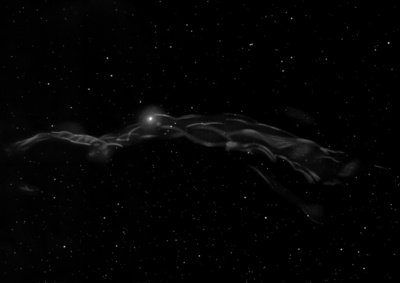
11x80 (5/26/84): both sections of Veil are easily visible in the 11x80 finder using a filter.
15x50 IS binoculars (8/27/11): the entire Veil was visible (eastern section was striking) using a pair of UHC filters threaded over the objectives. The western section through 52 Cygni took more care to view and the forked southern half was the most difficult section to pick up.
William Herschel discovered NGC 6960 = H V-15 = h2088 on 7 Sep 1784 (sweep 259) and recorded "Extended from one number to the other [in declination]; pB, taking in 'k' [52] Cygni in its extent. The milky ray is convex towards the following side in that part which lies north of k, pretty compact and equally bright. On the southern side of 'k' it is less bright and at last loses itself with some extension, perhaps in two braches, but it is not bright enough that I may determine this circumstance with certainty. The breadth of the northern parts is near 2', the southern branch is less defined." Soon after in the same sweep he encountered NGC 6979 (the northern section of the Veil). On the previous night (sweep 258) he discovered NGC 6992, the main eastern portion of the Veil and
JH recorded 3 observations. On sweep 178 he noted "The place is that of k Cygni, through which the nebula passes. It is very long and winding and runs northward from k full 2 fields breadth (30'). One branch is pretty conspicuous, even in a little moonlight. The nebulosity is milky, and does not seem to arise from small stars of the Milky Way." Isaac Roberts took the first photograph of the NGC 6960 on 28 Sep 1891.
300/350mm - 13.1" (5/21/82): this is the prominent western section of the "Veil nebula" and is spectacular with an OIII filter. Bright, extremely large, very elongated N-S, stretches across the entire low power field while passing through the bright unequal double 52 Cygni = 4.3/9.5 at 6". Fans out to the south and splits into two delicate branches and fainter wisps. The bright curving nebulosity north of 52 Cygni has a remarkable "electric" quality. It has an abrupt bend about midway and then tapers down to a narrow tip towards the north end gently bowing out towards the west side. Fantastic detail using a 20mm Nagler and OIII filter.
Notes by Steve Gottlieb
NGC 6992
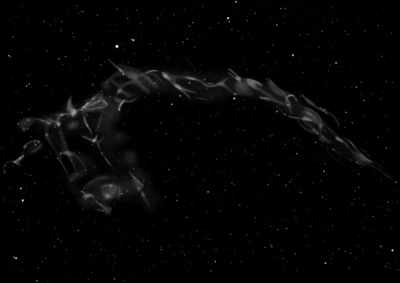
15x50 IS binoculars (8/27/11): NGC 6992/6995 is striking at just 15x using a pair of UHC filters threaded over the objectives as a long, curving filament. Although NGC 6960 through 52 Cygni was also visible in the same binocular field, it's is a tougher object, particularly the fainter (forked) southern portion.
William Herschel discovered NGC 6992 = H V-14 = h2092 on 6 Sep 1784 (sweep 258) and recorded "eF, above 3/4° long and 6, 8 or 10' broad. The whiteness entirely of the milky kind, brighter in 3 or 4 places than in the rest. The position of the ray or extent is from np to sf [northwest to southeast], making an angle of 30 or 40° with the meridian. The stars of the galaxy [Milky Way] are scattered over it in the same manner as the rest of the heavens. The time and number is taken in the brightest part of the nebula. The ray is faint enough to have been overlooked had it not been for the brighter places in it." The following night (sweep 259) he discovered the western section of the Veil Nebula NGC 6960) and reobserved the eastern section, finding "Branching nebulosity of the extent of the number that is 53' in polar distance, and in RA reaches through 5 or 6 fields that is near 1 1/2 degrees. The following part of it is divided into several streams and windings which after separating meet each other again towards the south." Herschel's rough sketch was publication in his 1811 paper (Fig. 1) as an example "of extensive diffused Nebulosity". NGC 6992 is generally applied to the northern portion of the eastern half of the Veil Nebula.
John Herschel first observed the Veil on 7 Sep 1825 (sweep 8) mentioned "The whole neighborhood seems affected with wisps or cirro-stratus-like masses of nebula." This was the original of the nickname "Cirrus Nebula", though the moniker "Veil Nebula" was probably first introduced by Leland Copeland. E.P. Mason made an excellent sketch in 1838.
200/250mm - 8" (5/21/82): bright at 50x with UHC filter. Some structure seen with darker rifts and branches at the south edge.
300/350mm - 13" (5/21/82): incredibly detailed at the south edge. Wispy structure with two long tails. Darker rifts and filamentary structure along the entire length.
400/500mm - 17.5" (7/5/86): this section of the Veil nebula is probably the most detailed and exciting emission object to explore in the 17.5" using a 20mm Nagler and OIII filter. Appears very bright, extremely large, very elongated, about 1° length, crossed by darker rifts. Feather-like side branches are at the south edge running off towards the west. The breathtaking filamentary detail at 83x using an OIII filter is too intricate to describe, particularly on the southern half! The filaments appear like intertwined threads or twisted ropes giving a striking 3-dimensional appearance along the length! Attached to NGC 6995 and IC 1340 to the south.
Notes by Steve Gottlieb
NGC 6888
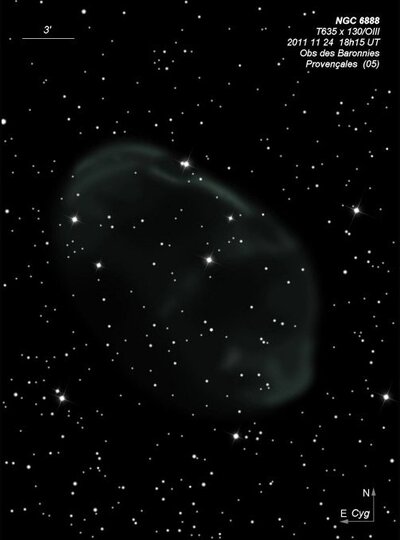
80mm finder (6/7/08): using 25x and an OIII filter, the brighter northern side of the shell was clearly visible and appeared locally brightest in an elongated arc on the north side passing through mag 7.2 HD 192182. A very faint hazy glow with no structure completed most of a large oval.
William Herschel discovered NGC 6888 = H IV-72 on 15 Sep 1792 (sweep 1027) and recorded "8m. Double. A faint milky ray south preceding joins to the double star; it is about 8' long, and is 1 1/2' broad." His position is within the interior of this Wolf-Rayet shell, but Bigourdan's corrected RA from 18 Oct 1895 (copied to the IC 2 notes) matches the brightest arc. Dreyer made three detailed observations and a sketch using the 72", which was published in plate V of the 1880 publication "Observations of Nebulae and Clusters of Stars".
NGC 6888 is illuminated by the Wolf-Rayet star
HD 192163 = SAO 69592 at 20 12.1 +38 21. This emission star was "discovered" spectroscopically by Copeland while sweeping with a Secchi prism at Dun Echt, Aberdeen and listed in MN 45, p91. Copeland noted "this is the 7.1 mag star DM +37°3821. It has a spectrum of several bright lines near D, and a very bright band in wavelength 464 mmm."
As far as the nickname "Crescent Nebula", in the 1920 Mt Wilson observations (based on 60" plates), Francis Pease description reads: "It is roughly elliptical, 18'x9', p.a. 42°. The N, Np and Sp edges include the bulk of the nebulosity, which gives it a crescent form, the bowl of which is filled with faint and scattered nebulosity."
100/150mm - 6" (8/23/03): used a 6" off-axis mask on my 18", along with a 31 Nagler (73x) and an OIII filter. A faint curving arc was visible which begins SW of the mag 7.2 star on the north edge and curves around to the mag 8.2 star on the NE side, extending nearly 90° of arc along the annulus of the Crescent Nebula. No other nebulosity was visible.
200/250mm - 8" (9/7/18): used an 8" off-axis mask on my 24-inch, along with a 31 Nagler (84x) and an OIII filter. I was surprised how much of the ellipse could be easily traced -- perhaps 240°, extending clockwise from mag 8.2 SAO 69611. The most prominent section is the piece SW of mag 7.3 HD 192182, but the thick section at the SW end with a somewhat lower surface brightness was easily seen.
8" (8/9/80): faint, elongated arc of nebulosity connecting two mag 7.5/8.5 stars and extending SW of the brighter star. Set in a very rich star field. Only the brightest portion at the north end of the nebula was noticed.
300/350mm - 13.1" (9/6/81): bright, large, oval shell, nearly complete loop visible with UHC, striking unusual appearance!
400/500mm - 17.5" (6/29/00): Stunning view at 100x (20mm Nagler) using an OIII filter. The outline appeared as a huge, irregular cosmic egg, ~18'x11', floating in a very rich Cygnus star field. The complete annulus as easily visible. The brightest section is along the north side and passes through a mag 7.2 star (very unequal double) at the north edge. This piece displays much structure with several knots and wispy tendrils. The interior has an irregular surface brightness with wispy striations that appear to radiate from the mag 7.4 Wolf-Rayet central star towards the NW rim at the end of the bright arc. The rim is widest on the SW end with more nebulosity filling in towards the center, including an isolated bright knot that is on a line passing through the mag 7.2 star on the north end and the central star. The fine texture and structure of the nebulosity creates an "electric" effect with a 3-dimensional sense.
17.5" (7/5/86): the "Crescent Nebula" is one of my favorite large nebulae at 100x with a OIII filter (excellent contrast gain). Appears as a bright, 16'x11' oval or egg-shaped annulus elongated SW-NE. The rim is virtually complete except for a small piece of the east side and exhibits a great deal of turbulent, wispy structure. The rim os brightest just SW of mag 7.2 HD 192182 (unequal pair O∑ 401 = 7.2/10.5 at 14"), which is embedded in the rim at the north end. The nebula also passes through mag 8.2 SAO 69611 on the NE side. Just north of center in the interior is the mag 7.4 Wolf-Rayet star HD 192163 = W-R 136, whose strong stellar wind created this shocked ring-type nebula. This is beautiful nebulosity set in a very rich Milky Way field.
600/800mm - 24" (9/7/18): absolutely gorgeous view of this huge cosmic bubble at 124x (21mm Ethos) and OIII filter. The entire very irregular oval outline was easily visible and full of wispy structure and wide variation in brightness levels. Two bright stars are involved along the rim; mag 7.2 HD 192182 (unequal double STT 401) in the center of the northern quadrant and mag 8.2 SAO 69611 on the northeast edge (7' separation). The sharpest curve in the annulus is the section connecting these two stars. Moving clockwise from these two stars, the highest surface brightness section of the nebula is a linear strip extending southwest of HD 192182. Mag 7.4 WR 136 (HD 192163) is nearby in the interior, 5.4' SSW of HD 192182. Very patchy nebulosity connects in a triangular wedge from HD 192163 to the western side of the rim, very close to the highest surface brightness section. Continuing clockwise, the annulus brightens on the southwest edge and spreads out (thicker annulus). This section is highly structured, though has a lower surface brightness on the inside edge. A fairly prominent "knot", at least 30" diameter, is within this pool of nebulosity on the south side, on a line with HD 192182 and W-R 136. Continuing clockwise, the irregular annulus is weakest on the southeast facing portion of the rim. The surrounding Milky Way field is plastered with bright and faint stars with a large number within the confines of the nebula.
900/1200mm - 48" (5/3/19): at 287x and NPB filter; I was amazed by the interior filamentary structure, particularly in the southern half that was not previously observed. I was surprised the nebulous filaments that connect the central mag 7.4 Wolf-Rayet star to the western rim continues SE of the star in a well defined, distinctive filament to the dim eastern rim.
Notes by Steve Gottlieb
NGC 6974
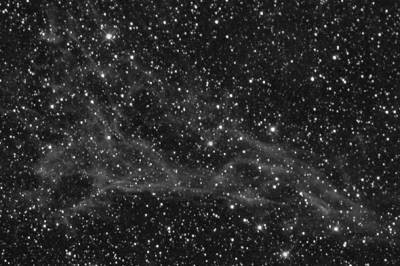
The NGC identification is very uncertain as the 4th Earl of Rosse's position was 74' further south and there is no nebulosity near his position.
Lawrence Parsons, the 4th Earl of Rosse, discovered NGC 6974 on 20 Aug 1873 and described a "Nebulous *, neby cE pf, 20h 45.5m NPD 59d 50'±." This position precesses to 20h 50.8m +30d 38'± (2000) and places it somewhere in the central region on the Veil.
The RNGC position is on the southeast end of the section that includes NGC 6979, over a degree due north of Parsons' position. Also, this piece of nebulosity is not "cE pf", but extended generally north-south." Still, Corwin feels this is a plausible candidate (digit error in the declination). In any case, the identification of this number is uncertain because of these discrepancies.
400/500mm - 17.5" (9/7/91): smaller southern portion of a very faint elongated patch with NGC 6979 in the Veil Nebula. Several faint stars are superimposed. Located east of the north edge of the widest section of the huge triangular wedge of nebulosity in the center of the Veil. Also see NGC 6979.
Notes by Steve Gottlieb
NGC 7000
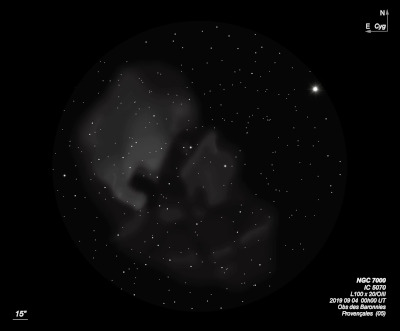
William Herschel discovered NGC 7000 = H V-37 = h2096 on 24 Oct 1786 (sweep 620) and recorded "vL. Diffused nebulosity plainly visible, bM, 7 or 8' length, 6' broad and losing itself gradually." In the next few minutes of the sweep he also commented, "All this time suspected diffuse nebulosity through the whole breadth of the sweep." He gave two positions at the east and southwest coast of the North American nebula, which became numbers 44 (Southeast US) and 46 (Central America region) in his list of 52 regions with "extensive diffused nebulosity." Arthur Auwers wrote (in a review of the General Catalogue) that JH omitted this large object, but NGC 7000 = GC 4621.
German Astronomer Max Wolf referred to this HII region as "The 'America' Nebula" in a 1902 German paper based on an image taken in 1901. In the 1903 paper "Diffused nebulosities in the heavens", Barnard refers to the object photographed by Wolf and states "The "North America Nebula" would perhaps be more definite, for it is North America to which Dr. Max Wolf intends the compliment." Agnes Mary Clerke refered to it as the "America" Nebula in the caption of Wolf's photograph in her 1905 second edition of "The System of the Stars"
200/250mm - 8" (5/26/84): bright, very large, sharp border and details around the "Gulf" section, "Southwest border" and "Baja region". Rich with faint stars. Viewed with a Rich Field adapter at 33x-50x.
80mm (8/23/84): striking contrast at 16x using a filter at Mt. Rose.
80mm (5/26/84): bright with a well-defined "Gulf" region at 13x using a narrowband filter.
400/500mm - 17.5" (7/17/93): at 100x and OIII filter appears very bright, extremely large (fills several fields), amazingly high contrast around the "Gulf" of Mexico and "Baja" region (LDN 935) and to a lesser extent along the west and east coasts. I traced around the entire border except for the "Canada" region, which consists mostly of scattered star fields with weak nebulosity. The open cluster NGC 6997 is easily picked out in the NE section.
Naked-eye - Easy naked-eye glow in a dark sky, though this is mostly from the rich Milky Way star cloud and not the involved nebulosity. The contrast is highest on the southwest side where the star cloud and nebulosity is adjacent to the dark "Gulf of Mexico" region.
Notes by Steve Gottlieb
M 39
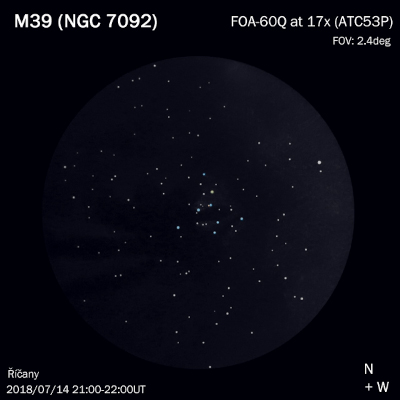
15x50mm IS binoculars (6/19/09): excellent at 15x with 25-30 stars resolved in a triangular outline. B68, a long dark streamer, is very prominent in the field to the southeast.
10x30 IS binoculars (6/13/07): naked-eye fuzzy patch is well resolved into ~15 stars in the 10x30 binoculars and approximately two dozen in the 15x50s. To the south of M39 begins the long dark streamer, Barnard 168, which is striking in 15x50 IS binoculars. This dark lane leads to the Cocoon Nebula (IC 5146), which is not visible in binoculars.
Charles Messier discovered M39 = NGC 7092 = h2126 on 24 Oct 1764, although as a naked-eye object it was probably noticed much earlier. On 27 Sep 1788 (sweep 866), WH logged "consists of such large and straggling stars that I could not tell where it began nor where it ended. It cannot be called a cluster." JH recorded on 14 Sep 1829, "A * 7m, one of a large loose cluster of stars 7 .... 10m; very coarsely scattered, and filling many fields."
200/250mm - 8" very bright, very large, 30' diameter, triangle shape, includes four bright stars mag 7 and ten fairly bright stars mag 8-9. Large and scattered so needs very low power. Partial resolution in 8x50 binoculars. Naked-eye cluster in a dark sky.
300/350mm - 13.1" (9/9/83): ~75 stars visible at 62x including 15 bright stars.
400/500mm - 17.5" (7/31/92): very bright, very large, about 30' diameter, scattered. Includes 18 bright stars mag 7-8. Most of the brighter stars form a triangular outline although a few bright stars are inside and outside. The bright star at the SE corner has about six faint stars close following. Includes several wide double stars. The bright stars are superimposed on a background of 100-150 faint stars. Fairly uniformly distributed though many stars are in short arcs and winding lanes. The faint stars are no richer than the Milky Way concentration. Best view with 20 Nagler at 100x.
Notes by Steve Gottlieb
M 29
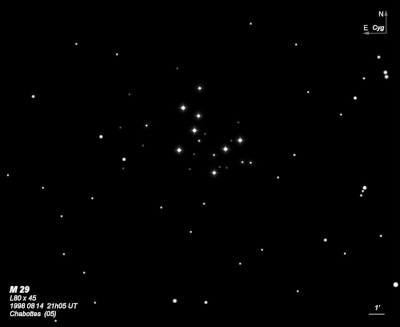
Charles Messier discovered M29 = NGC 6913 = h2078 on 29 July 1764. Caroline Herschel observed this group on 6 Apr 1783 and logged "About 1 deg under Gamma Cygni; in my telescope 5 small stars thus [diagram]. My Brother looked at them with the 7 ft and counted 12. It is not in Mess. catalogue." According to Michael Hoskins, the position and diagram applies to M29, despite her comment that it wasn't a Messier. On 15 Sep 1792 (sweep 1027), William Herschel recorded "a cluster of very coarsely sc. vL stars; not rich." JH reported "a coarse cluster of 8 large stars (10m) and a dozen or 20 smaller in a roundish form."
300/350mm - 13.1" (9/9/83): M29 consists of two dozen stars mag 8 and fainter in a fairly small trapezoidal outline well detached in the field. The six brightest mag 8 stars form two curving rows on the SW and NE ends. Appears loose with no dense spots and seems fully resolved.
Notes by Steve Gottlieb
NGC 6826
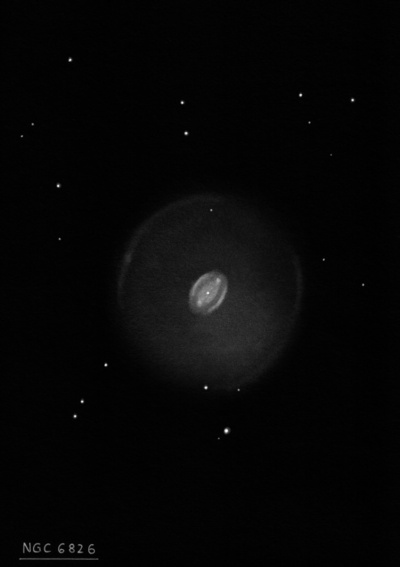
William Herschel discovered NGC 6826 = H IV-73 = h2050 on 6 Sep 1793 (sweep 1049) and recorded "a beautiful phenomenon. A bright point, lE, like two points close to one another; as bright as a star of the 8-9 magnitude surrounded by a very bright milky nebulosity suddenly terminated, having the appearance of a planetary nebula with a lucid center. The border, however, is not very well defined. It is perfectly round and I suppose about 1/2' in diameter. It is of a middle species between the planetary nebula and nebulous stars." JH recorded "a most curious object. A * 11m surrounded with a vB, perfectly R planetary nebula, of equal light throughout. Diameter in RA = 3.5 sec. Perhaps a little hazy at the edges. With 320x the * is not seen double."
On 28 Aug 1850, Bindon Stoney recorded at Birr Castle, "A very remarkable object, probably analogous to h450 [NGC 2392]. The dark ring is not easily seen, but there can be no mistake about it, seen by Lord R and myself, my brother (George Stoney) saw it dark under [preceding] the central star." Observing with a 9.5" refractor at 760x in 1856, Father Secchi described (and sketched) the outer halo resolving into a number of small stars and claimed it was an open cluster (AN 43, 157).
Based on Crossley photographs at Lick, Curtis (1918) wrote "The central star...is surrounded by an oval disk of bright matter 27"x24". Within this are rather obscure evidence of a brighter ring formation, the condensations at the ends of which are 22" apart in p.a. about 125°." An outer shell of 110" in diameter was first photographed with the 100-inch at Mt Wilson on 13 Aug 1936. It was looked for after finding an unsuspected outer envelope around M57.
The Herschels never mentioned a blinking effect, though it is less prominent in larger scopes. In an article titled "Suggestions to Amateurs: Nebulae and Clusters" by Lewis Swift in Popular Astronomy (1894) he mentions, "According to Professor Mitchell, "now you see it, and now you don't". The blinking effect was noted by James Mullaney and Wallace McCall in the August 1963 issue of Sky & Tel, though the nickname was coined by Mullaney.
200/250mm - 8" the famous "blinking" planetary blinks well with this aperture. Contains a bright mag 10 central star (HD 186924) visible with direct vision and the outer nebulosity dominates with averted vision.
400/500mm - 17.5" (8/17/01): beautiful view at 500x; the disc is slightly elongated WNW-ESE, with subtle structure. There is small, slightly darker region around the bright 10th magnitude central star. The halo appears to dim slightly along the preceding edge and this edge is not as sharply defined. Located 28' E of the double star 16 Cygni.
17.5" very bright 25" roundish nebula surrounding a bright 10th magnitude central star, slightly elongated ~E-W, high surface brightness. With direct vision the planetary appears brighter on the south side. The planetary is too bright with this aperture to have the striking "blinking" effect seen with smaller apertures.
600/800mm - 24" (9/13/12): at 325x the main 30" disc appeared slightly brighter in the east-southeast region. Adding an H-beta filter, a very small knot was sometimes visible near the rim at the east edge. This difficult knot is prominent on the HST image as a red FLIER (Fast Low-Ionization Emission Region). The corresponding knot on the west edge was not visible. The red color of these FLIERS is from ionized nitrogen and it disappeared switching to an OIII filter, although the large outer halo became visible.
24" (8/16/12): at 300x and an OIII or NPB filter, the main high surface brightness disc (slightly elongated) is surrounded by a very faint, fairly uniform giant halo, extending 2' diameter and quadrupling the size of the bright 30" disc! The outer halo seemed perfectly round with a well-defined edge and was easily visible.
900/1200mm - 48" (10/27/16): at 610x and 813x; both internal FLIERS (see observation below) were visible on the NW and SE sides of the central disc. The disc had a slight bulge on the northwest and southeast ends creating a slightly elongated, irregular oval NW-SE. A fainter inner halo was visible at 610x, roughly doubling the size. At 244x and NPB filter, a third large outer shell was fairly prominent forming a well defined 2' circular halo.
Notes by Steve Gottlieb
NGC 6946
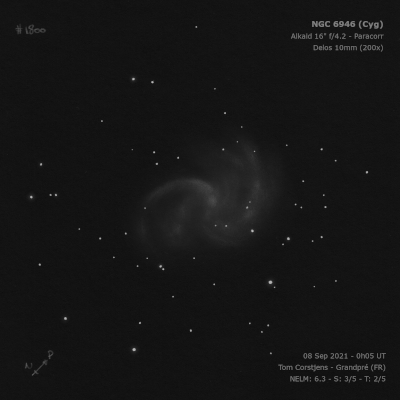
William Herschel discovered NGC 6946 = H IV-76 = h2084 on 9 Sep 1798 (sweep 1077) and recorded "cF, vL, iF, a sort of BNM. The nebulosity extends 6 or 7'. The N seems to consist of some vS stars; the nebulosity is of the milky kind. It is a pretty object." John Herschel made 3 observations and on 11 Aug 1831 logged "vF; eL; vglbM; r; 5' or 6' dia; irreg fig. A curious object; no doubt a great cluster of eF stars. Requires the eye to be well prepared for seeing it."
Bindon Stoney, LdR's assistant on 6 Sep 1850, described a "New spiral, very fine but faint; 3 branches, of which two terminate in knots, a fourth branch north preceding very doubtful." Two nights later he made an excellent sketch (Plate XXX, fig. 36) that was included in the 1861 publication. On 6 Sep 1855, R.J. Mitchell recorded, "The two following branches unite in one before meeting the nucleus; I certainly see a fourth branch preceding which seems to join the other preceding branch in the same way before reaching the nucleus. Of the four, those which terminate in knots are the brightest."
E.E. Barnard reported (Sidereal Messenger, vol. 5, p286) he first viewed NGC 6946 around 1881 with the 5-inch refractor and marked it as "vvF". But on 28 May 1885 he found it "almost bright, certainly not faint. It is moderate in size, round, vgbM with some small stars grouped around it. Its brightness is a little less than cluster GC 4590 [NGC 6939]."
Ten supernovae (most of any galaxy) have been detected in NGC 6946 as of 2017. The first, SN 1917A, occurred on 19 Jul 1917 when it was discovered by Ritchey and was considered a nova. This supernova, situated 37" W and 105" S of the galaxy's nucleus, peaked at 14.6 mag.
200/250mm - 8" (6/22/81): faint, large, diffuse, brighter core. Situated in a rich star field.
300/350mm - 13.1" (7/27/84): bright arm on the east side highly suspected to branch or split into two arms. Also an arm or brighter region seen on the opposite side of the galaxy pointing west a short way.
13.1" (7/16/82): the central region is elongated and fairly low surface brightness though a spiral arm clearly trails off to the east from the main body creating a non-symmetrical appearance.
400/500mm - 17.5" (8/29/92, White Mountains at 12,000 ft): bright, very large, 6' diameter to main body, elongated 3:2 ~E-W. Three arms are visible. A long bright arm is attached at the north side of the core and trails to the east (Arp's "One Heavy Arm"). This eastern arm splits; a short fainter branch bends south following the core and a long curving bright arm terminates with a very faint, very small HII knot (HK83 #3). On the west side a fainter arm shoots sharply to the north from the core. These outer arms significantly increase the diameter of the main body. The galaxy has a very large brighter middle but the core is just a very small brighter region close SW of the geometric center. A very faint stellar nucleus was seen with direct vision.
17.5" (8/13/88): main spiral arm very prominent and easily seen to split.
17.5" (9/14/85): bright, large, brighter central core. A prominent arm is attached on the NE side of the core and trails to the east. This arm splits - the shorter arm is close to the core and a brighter region or arm to the west.
600/800mm - 24" (5/20/17, 5/22/17 and 6/23/17): Type II Supernova 2017eaw in NGC 6946 was easily identified as a 13th magnitude "star" 2.7' NNW of the nucleus using a photographic finder chart. I was surprised the supernova was only slightly fainter in June, over a month later than first viewed. This is the 10th known supernova in the galaxy.
24" (9/13/12): the bright, long, outer spiral arm on the north side passes very close south of a mag 13.5 star before terminating near the small knot HK83-3 = H69-1. Besides the knot at the end, this arm is a bit clumpy with two slightly brighter regions roughly 1.7' N of center, HK83-213 = H69-11, and 2.4' NE of center, HK83-123/124 = H69-10. The spiral arm extending north on the west side has several mag 14 stars superimposed. A very small brighter nucleus is embedded the very broadly brighter central region.
900/1200mm - 48" (10/23/11): this very bright, showpiece face-on spiral stretches roughly 9'x7' E-W. At 375x, four arms were visible, each containing one or more HII regions. The brightest arm is attached on the west side of the central region and curves counterclockwise to the north and then heads east, passing just south of a mag 13.5 star and spreads out to the NE of the central region. At the eastern tip (4.2' from center) is a bright HII knot of 12" diameter, catalogued as #3 under NGC 6946 in Paul Hodge and Robert Kennicutt's 1983 "Atlas of HII Regions in 125 Galaxies" (HK83-3) and #1 in Hodge's 1969 paper "HII regions in twenty nearby galaxies" (H69-1). A second shorter arm vaguely emerges from the core on the north side, and rotates more sharply around the galaxy on the north side, passing south of the brighter arm, and curving around to the east side. It contains HK83-63/76 = H69-6, an elongated knotty HII complex at its tip, 2.5' due east of center.
On the west side are two additional arms, though the brighter inner arm is better defined. It begins on the south side of the central region and curls sharply to the north on the west side. It passes through a few mag 14 foreground stars and nearly fades out 3.2' NW of center. A dim extension finally ends 3.5' N of center at HK83-285 = H69-20, a very faint, very small knot inside a triangle of stars. An outer arm on the south side rotates towards the west and intersects HK83-503/507 = H69-33, a very bright, round knot of 20" diameter, that rivals the inner core in size. Using a DGM Optics "Galaxy Contrast" filter, the core was dimmed more and the knot appeared nearly as bright. Studies reveal this feature is a circular bubble containing numerous, tightly packed small clusters and a bright supermassive star cluster that resembles a young globular. After this point, the arm becomes more patchy as it spreads to the northwest, but near the end is HK83-527/528, an extremely faint knot just west of a mag 14 star 3.5' NW of center.
Notes by Steve Gottlieb
NGC 7008
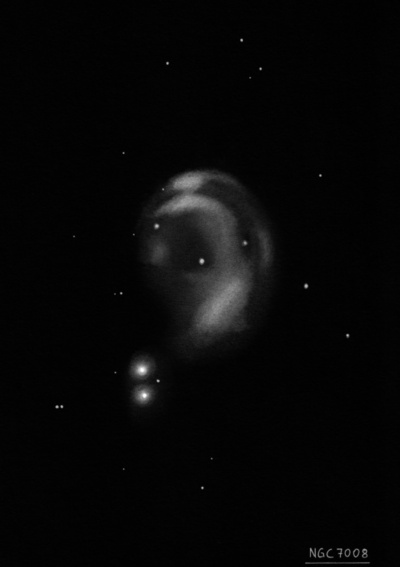
80mm (9/10/07): the planetary was faintly visible in the finder at 25x using an OIII filter.
William Herschel discovered NGC 7008 = H I-192 = h2099 on 14 Oct 1787 (sweep 765) and recorded "cB, strong nebulosity of an irregular square figure. Seems to contain faint large stars, about 3' l and 2 1/2' broad." Two nights later (sweep 768) he noted "the stars which are visible in it, do not seem to belong to it." On sweep 211, JH logged "L; E; r; has an appearance of two nuclei or points of greatest condensation; it touches a fine double star [h1606 = 9.3/10.2 at 18"]." R.J. Mitchell, LdR's assistant on 19 Aug 1855, recorded "seen as in sketch [PT 1861, pl XXX, fig 37]. 3 st in it, F neby reaches nearly up to the star sf; B knots in it, the nf one seems triangular in shape and sometimes I thought it split up by a dark line from sf to np."
Based on Crossley photographs taken at Lick, Heber Curtis (1918) reported "irregular ring structure indicated; the dimensions are 86"x69" in p.a. 20°. The two brightest patches are at the north.. three stars lie in roughly circular gaps in the nebulosity..."
In a 2001 issue of Amateur Astronomy magazine, Eric Honeycutt called NGC 7008 the "Fetus Nebula" due to its appearance in his 22-inch telescope.
200/250mm - 8" (9/11/82): unusual structure, curves and extends further south on the west side. A faint star is embedded.
300/350mm - 13" (9/11/82): bright planetary with unusual structure and several stars involved. The striking complete annular ring is elongated SW-NE. A mag 14 central star mag is visible as well as a mag 14 star at the NE edge and a faint star is off the west edge. A small brighter knot marks the NE end. The planetary is located just north of h1606 = 9.3/10.5 at 18" separation.
400/500mm - 17.5" (6/28/00): this beautiful, highly structured PN is situated just north of a wide double star (9.2/10.5 at 18"). At 280x, the annular oval is elongated SSW-NNE, ~90"x65". A bright 30" irregular knot is prominent at the NE end. The SW end of the major axis has a fainter condensation and the rim is clearly dimmest near the double star. The mag 14 central star shines steadily as does a slightly fainter mag 14.5 on the NE edge. Just off the west edge is another 14th magnitude star. The darker center is faintly luminous and the surface brightness is irregular over the entire oval giving a mottled, wispy appearance.
900/1200mm - 48" (10/24/14): We had a superb view of NGC 7008 unfiltered at 488x and 610x. This irregular, annular planetary extended ~1.5'x1.2' SSW-NNE with a roughly oval outline, except on the southwest end. Several stars are involved or just off the edge, including h1606 = 9.6/11.7 at 19” separation, which is just off the SSE edge. A very bright, elongated knot is at the NNE edge of the rim. A larger elongated knot is just on its inside (towards the central star), with the pair of close knots virtually attached. On the opposite SSW end is the next brightest region, extending nearly 45° along the rim. This larger glow spreads irregularly into the darker center and dims. Another brighter knot is on the WNW edge of the rim (probably K 4-44), just northeast of a mag 14 star that is close off the west edge. Finally, another slightly brighter knot is at the east edge of the rim, close south of a mag 14 star on the northeast side. The entire southwest side appears as if it was "nibbled" around the edges, as part of the outer edge is missing. A mag 13.5 star sits in the center of the darker interior with the central "hole" darkest immediately east of the central star. Another darker region is in the southeast quadrant just north of h1606.
Notes by Steve Gottlieb
NGC 7048
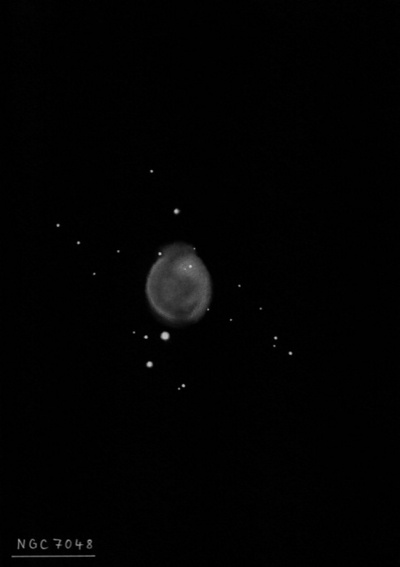
Édouard Stephan discovered NGC 7048 = St IX-28 on 19 Oct 1878. His micrometric position is very accurate. At +46° declination, NGC 7048 is the most northerly object discovered by Stephan at Marseilles as he only searched up to the zenith.
In 1919, Heber Curtis reported it was undoubtedly a planetary nebula based on a Crossley photograph and described it as "A rather faint oval, with slight traces of ring structure. It is about 60" x 50" in p.a. 20°±. The brightest portions are at the east end of the minor axis. There is a very faint central star." In 1920, Francis Pease reported it was "a planetary resembling the Dumb-bell nebula, about 1' diameter, weak axis in p.a. 170°. The central star is very faint."
400/500mm - 17.5" (8/7/91): bright, fairly large, slightly elongated N-S. Extends between a mag 10.5 star just off the south end (46" from the center) and a mag 13 star off the north end (1.0' from center). Extremely faint stars are superimposed at the west and NNE edge. Appears slightly brighter along the west and east side of the disc and the planetary has a slightly darker center (weakly annular). No central star was visible. Located 3.3' ENE of mag 8 SAO 50601.
600/800mm - 24" (8/30/16): at 376x unfiltered; fairly bright, moderately large, very slightly elongated N-S, seen full size at ~60" diameter. The rim is slightly brighter along and the western side and very weakly enhanced on the eastern edge. On the northwest side is a brighter, circular region with a faint (interior) star embedded. Overall the planetary has a very weak annular appearance. A mag 8.3 star is 3.3' WSW, a mag 10.5 star is off the SSE edge [42" from center] and a faint star is barely off the NE edge [30" from center].
900/1200mm - 48" (10/27/16): at 375x (unfiiltered); bright, fairly large, nearly round, irregular surface brightness. The rim is slightly brighter along the west and northwest side in a thin strip and very weakly enhanced on the east edge. A bright mag 10.5 star is just off the SSE edge and a mag 15.7 star is very near the NNW edge (180° opposite the bright star). There is one brighter interior star on the northwest side [17" from center]. In addition a couple of very faint stars are superimposed.
Notes by Steve Gottlieb
NGC 6894
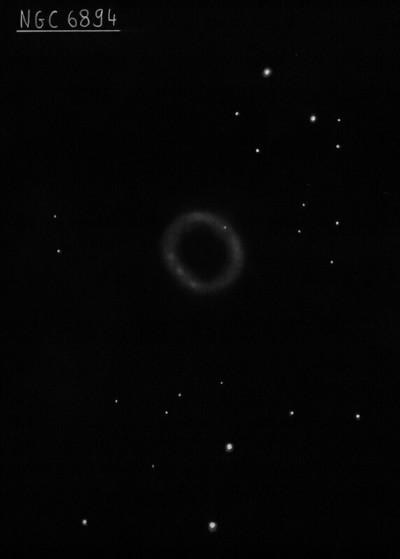
William Herschel discovered NGC 6894 = H IV-13 = h2072 on 17 Jul 1784 (sweep 239) and recorded "pF, exactly R, of equal light throughout. I believe it is resolvable, but am not certain, about 1' in diameter." He published a sketch in his 1811 paper (Fig. 33) as an illlustration of "nebulae that are of an almost uniform light."
John Herschel made several observations. On 4 Sep 1825 (sweep 7), he logged "planetary nebula; diam [by inexperienced estimation] = 1'; light equable; exactly round; vF, a mere ghost." On 1 Aug 1829, he recorded "eF; annular; pretty sharply defined; a very little elliptic; the northern limb is the brightest; the darkness in the middle requires some attention to see; but once seen it cannot be mistaken. A most curious object, resembling much the annular nebula in Lyra, but rounder, small (not above half the diameter) and far fainter."
LdR (or assistants) also described NGC 6894 as "annular" on 23 Aug 1851 (first observed on Aug 1 1848): "fine annular nebula like that in Lyra, R, the dark space is E pf, star easily seen in np edge and others suspected."
Based on Crossley photographs taken at Lick Observatory (earliest in 1899), Heber Curtis called NGC 6894 "The Annular Nebula in Cygnus". He reported "the central star is about mag 16. A very vague and indistinct ring, 44" in diameter along a major axis in p.a. 50°. Quite faint; the brightest patch is at the north, near the 14th mag star involved in the ring."
300/350mm - 13.1" (9/9/83): fairly faint but easily visible at 88x. Darker center just visible at 144x-176x with averted vision.
400/500mm - 17.5" (9/14/85): moderately bright and large, round. Annular appearance at 105x using an OIII filter and exhibits an obvious darker center at 222x and 294x with a UHC filter.
600/800mm - 24" (7/1/16): at 375x; striking annular planetary ~45" diameter, the annulus is relatively thin giving a nice 25" darker "hole". The rim in slightly irregular in brightness and thickness and appears weakly enhanced along the northern side. A faint star is visible on the inside edge of the ring at the NNW side.
Notes by Steve Gottlieb
IC 5146
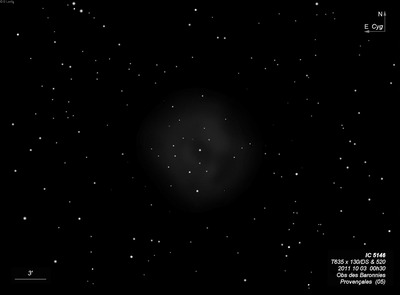
E.E. Barnard discovered IC 5146 = Cocoon Nebula on a photograph taken 11 Oct 1893 using the 6" Willard lens at Lick Observatory. Max Wolf also photographed the field on 28 Jul 1894 with the 6-inch camera at Königstuhl. Wolf announced his discovery with a photograph taken on 10 Jul 1904 and discussed the dark lane (Barnard 168) and nebulosity in detail in his paper "Remarkable nebula in Cygnus" (MNRAS, 64, 838,1904).
Mary Clerke, who was in correspondence with Wolf at the time, includes Wolf's 1904 photograph (plate XX) in her second edition (1905) of "The System of the Stars". She labeled the photograph "The Cocoon Nebula in Cygnus" and writes (p. 352) "The depicted nebula, which had been discovered ten years previously, is about 10' in diameter, of a round shape, and a complex structure. "It is placed centrally," Dr. Wolf writes, "in a very fine lacuna void of faint stars, which surrounds the luminous cloud like a trench." Moreover, this negative "halo forms the end of a long channel, running eastward from the western nebulous clouds and their lucanae, to a length of more the two degrees." The coexistence in the same sidereal district of nebulae and stars could not well be asserted with stronger emphasis than by clearly of a dark fosse for the accommodation of the cocoon-like object in Plate XX." I tracked down the nickname after a discussion on AMASTRO in August 2015.
The Reverend Thomas Espin discovered the nebula visually on 13 Aug 1899 and described object #6 in AN [3633] 152, 141 as a "large, faint glow about 8', well seen each night [2]." Espin and Wolf is credited with the discovery in the IC.
Dave Riddle notes that B168 could apply to both the bright nebula and the associated dark lane. Barnard refers to a "small nebula at the E end of dark lane. This nebula is 10' in diameter with over a dozen stars of different magnitudes in it. There is no central condensation, nor does the nebula condense about any of the stars. There are some dark markings in it. The dark lane is 1.7 degrees long and 9' wide."
200/250mm - 8" (8/12/83): about 20 stars over a very faint "milky" region, fairly large, just slightly higher contrast than Milky Way background. A short arc of stars is off the west edge. A long starless dark lane extends west. Two bright stars oriented N-S are just east.
400/500mm - 17.5" (8/8/91): at 82x using an H-Beta filter, the Cocoon Nebula appears fairly bright, very large, about 10' diameter. Surrounds six stars including two bright mag 9-10 stars embedded near the center and at the south edge. Has an irregular round shape with a very irregular surface brightness with dark mottling and brighter regions. The nebula is quite prominent using an H-Beta filter, which gives an excellent contrast gain (higher than OIII). The nebulous glow is superimposed on a scattered star group and is situated at the east end of long dark lane = B168 which extends 1° WNW! (excellent in binoculars). There is a distinctive edge to the Milky Way on the north edge of lane.
Notes by Steve Gottlieb
NGC 7026
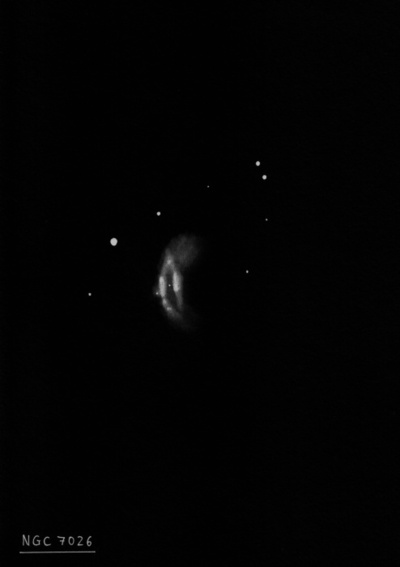
Sherburne Burnham discovered NGC 7026 on 6 Jul 1873 with his personal 6-inch Clark refractor at his home in Chicago (Memoirs of the RAS, Vol 44, p295). It was described in his "Third Catalogue of Double Stars (1873) as "a very remarkable and curious double, or elongated planetary (?) nebula. It is close to a 9.3m star. This may have been noted before, but it is not in Herschel's General Catalogue, or Lassell's Catalogue of New Nebulae." It was also included in his 1879 "Double Star Observations made in 1877-8 at Chicago with the 18 1/2-inch Refractor of the Dearborn Observatory, comprising: I. A Catalogue of 251 New Double Stars with Measures; II. Micrometrical Measures of 500 Double Stars." He noted the "distance between nuclei as 2.57". Dreyer missed Burnham's two discovery notes, so NGC 7026 wasn't added to the General Catalog Supplement.
Ralph Copeland independently found this planetary on 18 Nov 1880 using a visual spectroscopic sweep and announced "a new planetary nebula has been found by Dr. Copeland at Dunecht, using Prof. Pickering's method of search." Burnham caught Copeland's "discovery" note and claimed priority in another 1881 article ("The planetary nebula in Cygnus"). Burnham later studied NGC 7026 with the 36" Lick refractor.
In 1909, Rev. Thomas Espin wrote (1909MNRAS..70..184E), "This autumn I have observed the nebula on several occasions. It consists of two elongated masses running N and small, each of which has a nucleus. To my eye the preceding nucleus is slightly brighter, and I have estimated them as 11.2, 11.4 mag, respectively. On Nov. 15 it seemed to me that the south part of the nebula ends more abruptly than the north. On the same night a faint star was suspected at the south end, and attempts were made to measure it. On all occasions the space between the two masses has seemed filled with nebulosity, and the object has appeared as one nebula with two nuclei."
Based on Crossley photographs taken at Lick, Heber Curtis (1918) reported "very irregular; there are two bright lobes 5" long in the shorter exposures symmetrically placed with regard to the central star, and about 6" apart from center to center. A bright of nebulosity connects these and involves the central star, so that it resembles the letter H. Irregular wisps extend from each end of this formation, making the total length about 25" in p.a. about 10°.
Jay McNeil coined the nickname "Cheeseburger Nebula" in 1994 with a 10" f/5 Cave reflector. "It very much so reminded me of a small, nebulous hamburger with two perfectly shaped "buns" separated by a long thin dark lane (the meat ;-)."
300/350mm - 13" (9/3/83): at 333x appears fairly bright, very small, elongated WSW-ENE. Two brighter condensations at the opposite ends are possibly barely detached at the center. Forms a double at low power with a comparable mag 11 star 27" NE of center.
400/500mm - 17.5" (7/9/99): fascinating object at 380x both with and without a UHC filter. The double-lobed structure is clearly visible with the western lobe slightly elongated N-S and containing a brighter center. The eastern knot also has a quasi-stellar center at moments using direct vision and the knot has an irregular outline. Using the UHC, the lobes are more cleanly separated and the small fainter halo that encases the two bright lobes is more obvious. A mag 11 star is just 0.5' NE of center. Located 12.5' NNW of mag 4.7 63 Cygni.
Notes by Steve Gottlieb
NGC 6871
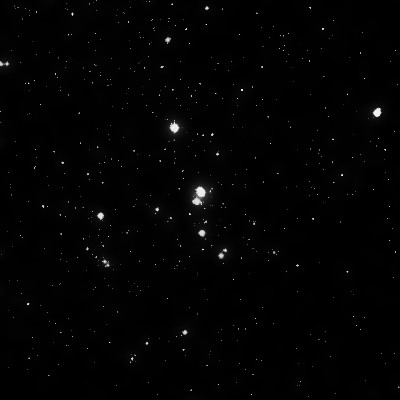
Wilhelm Struve discovered NGC 6871 = h2067 in 1825 or 1826 using the 9.6" refractor at the Dorpat Observatory and included the double star ∑2630 in his main catalogue of double stars. On 5 Aug 1831, JH recorded "A double star ∑2630, in a cluster of 5 bright and many small stars." His position is near the two bright double stars in the center of the cluster and he credited Struve with the discovery.
But by analyzing William Herschel's early "reviews" of bright stars (before his systematic sweeps), which resulted in the discovery of many double stars, Wolfgang Steinicke found (email Oct '16) that Herschel first discovered the cluster on 23 Sep 1783 using his 6.2" reflector.
200/250mm - 8" (6/81): two sets of multiple stars in a very rich field including ß440 = mag 7, 12, 11, 9.5, 11.5, 8 at 7", 11", 11", 28" and 36". Located 13' SW of a mag 5.5 27 Cygni.
300/350mm - 13.1" (8/25/84): dominated by two bright multiple stars: SHJ 314 = 6.8/7.3 at 35" with four additional close companions and SHJ 315 = 7.9/8.8 pair at 20" surrounded by several mag 11 stars. The bright pairs are oriented N-S and separated by about 2'. The cluster itself is in a bright, rich field with no apparent boundaries.
400/500mm - 18" (9/26/11): bright, large, rich cluster but not isolated in the field, so the catalogued diameter of 20' seems somewhat arbitrary. At 175x, roughly 200 stars are visible within the region, though there are really too many to count. The dominant feature are two bright multiple stars near the center: SHJ 314 = 6.8/7.3 at 35" with 4 faint companions and SHJ 315 = 7.9/8.8 at 20" with 8 companions including a trio of mag 11 stars close west, a 15" pair of mag 10.5 stars close east and a tight string of 3 or 4 fainter stars close southeast. NGC 6871 forms a close pair of clusters with Biurakan 1 (centered on a mag 7.3 star), just off the southeast side. The little-known Wolf-Rayet shell surrounding W-R 134/135 lies 45' NE.
Notes by Steve Gottlieb
NGC 6811
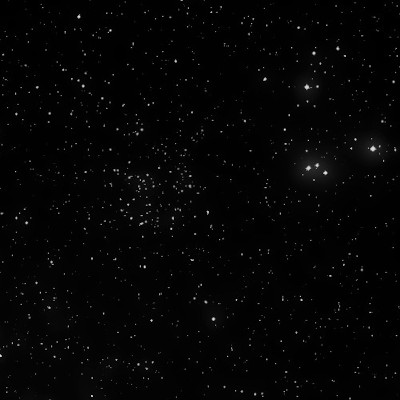
John Herschel discovered NGC 6811 = h2044 on 29 Aug 1829 and recorded "a double star in the southern part of a fine, large, pretty rich coarse cluster of about 100 stars 11...14m; it fills the field." His position is near a mag 11 star on the southeast end of the cluster. The next sweep (2 Sep 1829) he logged "The centre of the more condensed part of a considerable cluster, 10' diameter, of irregularly scattered stars." His position, though, is about 45 seconds of RA too large. Harold Corwin mentions "Unfortunately, the position JH adopted for the GC carries the RA of the second, and a Dec 10 arcmin further on north. I think he meant to use only the second observation (he notes that the first observation refers to "A double star in the southern part ..."), so the incorrect Dec must be a transcription or typographical error." The end result is the GC and NGC position is 15' too far northeast, well outside the confines of the cluster.
300/350mm - 13.1" (9/3/83): fairly large and rich group of approximately 60 stars including many mag 11-12 stars. A long trail of stars follows and a bright group of stars is WNW. Prominent in 16x80 finder, some resolution with averted.
400/500mm - 17.5" (7/1/00): large, beautiful cluster at 100x. The central section is ~8' in diameter, roughly triangular and contains a scattering of ~20 10-11th magnitude stars. There are no prominent members - the brightest star (at the west edge) has a faint companion. Perhaps 85 stars are resolved in the unconcentrated central region (there is nearly a void in the center) over haze. The richest knot of stars is on the northeast side. An isolated 5' tails of stars extends NW and another curving string of stars can be traced 8' to the east.
Notes by Steve Gottlieb
NGC 6819
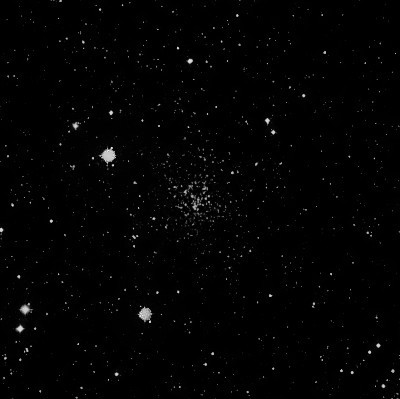
Caroline Herschel discovered NGC 6819 = h2048 on 12 May 1784. William didn't record the cluster during his sweeps (though observed it on 31 Dec 1801), so it doesn't carry an H-designation. Karl Harding independently found it in 1823, reported the discovery to Johann Bode, and it was listed as new in Astronomisches Jahrbuch for 1827 (published in 1824). John Herschel rediscovered it again on 31 Jul 1831 and logged "a beautiful cluster, v rich, vL; stars 11...15m and l = 7m nf, a reticulated mass, central part = 4', but fills field with its loose stars. A very fine object." His position is accurate.
200/250mm - 8" (9/11/82): rich, well-resolved, pretty.
300/350mm - 13.1" (9/11/82): striking cluster at 144x. Nearly three dozen stars are resolved over haze mainly in two rows. This is a very rich, dense group.
400/500mm - 17.5" (7/1/00): this is a rich, beautiful cluster at 100x. The central 6' contains 80-90 stars over unresolved haze and has an irregular outline with the brighter stars forming a squared off "U" shape open to the north. The cluster extends to ~8' diameter with many faint stars on the SW side. The outline appears elongated SW-NE with the inner bars of the "U" on the NE border delineating a distinct border. Located 8.5' SE of mag 6.3 HD 186307.
Notes by Steve Gottlieb
NGC 6910
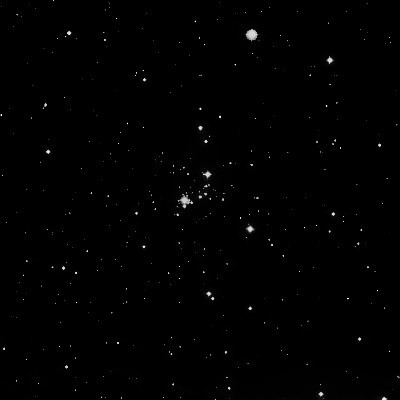
William Herschel discovered NGC 6910 = H VIII-56 = h2077 on 17 Oct 1786 (sweep 612) and recorded "a small cluster of coarsely scattered stars, of various sizes; of an extended form; like a forming one [cluster]." On 1 Oct 1828 (sweep 183) John Herschel logged "a poor and coarse but rather brilliant cl, 2 st 9m (the np taken) and 30 or 40 more 10...12."
400/500mm - 17.5" (8/7/91): about 40 stars mag 7.5-15.5 in a 7' diameter dominated by two mag 7.5 stars oriented NW-SE. A mag 7.4 star (SAO 49556) with two faint companions is at the NW end and a mag 7 star (SAO 49563) is at the SE end surrounded by a rich group of 10 mag 12-13 stars. Most of the cluster's brighter mag 10-11 stars are arranged in a NW-SE string just west of the line connecting the two bright stars. A second curving offshoot to the west consisting of three mag 10 stars gives a "Y" shape to the cluster. Located 40' NNE of Gamma Cygni (V = 2.2) within a section of the IC 1318 complex.
Notes by Steve Gottlieb
NGC 6866
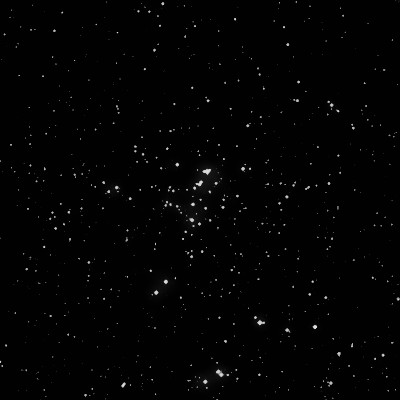
Caroline Herschel discovered NGC 6866 = H VII-59 = h2066 on 23 Jul 1783. William Herschel probably found the cluster on 16 Oct 1783 (before his sweeps). On 11 Sep 1790 (sweep 959) he rediscovered the cluster (unaware of the previous observations) and logged, "a very rich cl of L stars, considerably compressed, above 15' diam. By the size of the stars, it is situated among the milky way towards us." His position is accurate. Karl Harding found the cluster again in 1823, reported it to Johann Bode and it was listed as new (#8) in Astronomisches Jahrbuch for 1827 (printed in 1824). John Herschel made the single observation on 21 Aug 1829: "a coarse rough cluster. Taken for VII. 59, but the place does not agree." His position is on the double star HJ 1478 = 10.3/10.9 at 2.2", which is situated 10' south of the cluster.
Brian Skiff found the Lund catalogue has a -10' error in declination, and this error may be carried over into over sources (misplotted on the Millennium Star Atlas).
400/500mm - 17.5" (9/7/91): about 100 stars in a 20'x10' region are visible at 100x. Appears rich and very appealing. The main string is very elongated roughly E-W and contains a brighter intersecting subgroup 8'x2' NW-SE of about 45 stars with a close triple star on the NW end consisting of a mag 10 star and two very faint companions. Two mag 10-10.5 stars are at the SE end of this string. The western end of the main string curves north into a nice semi-circle.
Notes by Steve Gottlieb
NGC 6834
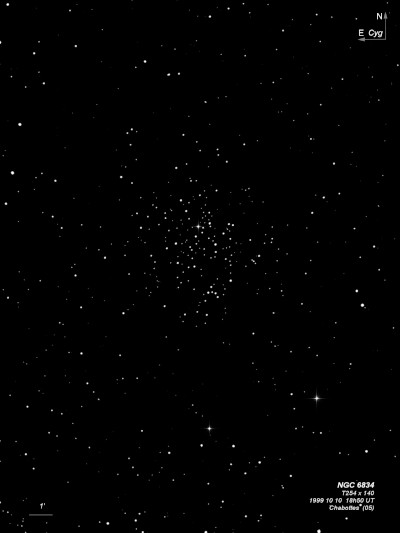
William Herschel discovered NGC 6834 = H VIII-16 = h2054 on 17 Jul 1784 (sweep 239) and recorded "a cl of not very compressed stars; closest in the middle. It may be compared to a cluster which is forming or gathering and not yet arrived to the state of those that are more advanced, or contain more stars." JH logged this cluster as "coarse irreg R; with detached portions of smaller stars. Those in the main cluster = 11 or 12 mag." His position was accurate.
400/500mm - 17.5" (8/7/91): 40 visible stars in a 8' diameter. A mag 10 star is in the middle of a line of seven mag 13 stars oriented SW-NE and also at the center of four mag 11/12 stars on a line oriented E-W. Sprays of stars emanate from the bright star to the SW and SE. A small clump of five stars lies 4' S of the mag 10 star. Planetary nebula NGC 6842 lies 38' ESE.
Notes by Steve Gottlieb
NGC 7086
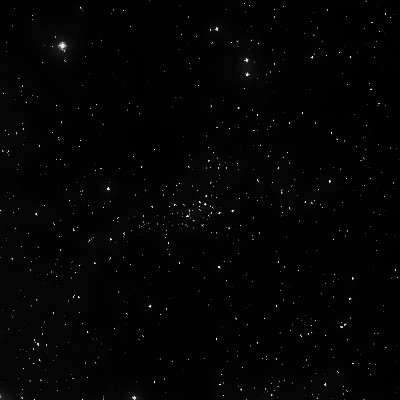
William Herschel discovered NGC 7086 = H VI-32 = h2124 on 21 Sep 1788 (sweep 860) and recorded "a beautiful cl of pretty compressed stars, 8 or 9' diam, considerably rich; nearly round." On sweep 384, JH logged "a rich fine cluster of st 11...16m; it fills field; but the most compressed part is about 6' in extent. The middle of the cluster taken, but no particular star fixed upon."
400/500mm - 17.5" (9/7/91): about 75 stars mag 10-14 in a 10' diameter. Fairly rich and contains six brighter stars. Most stars are located in a compact, rich, 5' group. A second group is to the north. A straight line of stars trails off to the SE with a mag 9.5 star at the end of the string. Includes several faint double stars. There are two large dark voids to the NE. This is a pretty cluster at low power using a 20mm Nagler.
Notes by Steve Gottlieb
NGC 6857
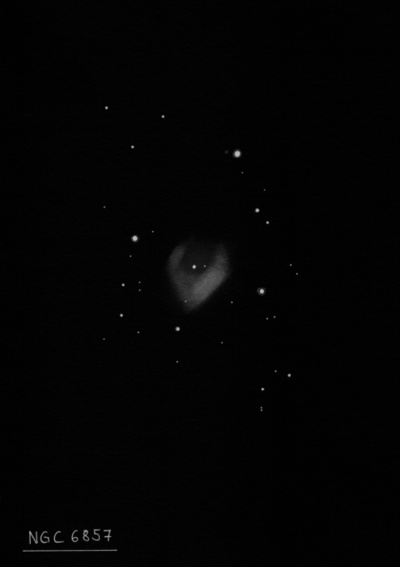
William Herschel discovered NGC 6857 = H III-144 = h2062 on 6 Sep 1784 (sweep 258) and recorded "a patch containing some nebulosity. 240 confirmed it, irregularly long." John Herschel made 3 observations and wrote on 1 Aug 1829 (sweep 198), "a nebulous looking patch; 12" diam; in Milky Way; ill-defined; perhaps only some extremely minute stars mixed with larger which as distinct." This nebula wasn't found (one attempt) at Birr Castle.
400/500mm - 17.5" (8/7/91): very bright, moderately large, about 1' diameter, irregular outline, roughly circular but edges difficult to define, irregular surface brightness. The mag 13.5 central star is quite prominent offset north of center. Surrounded by four fours; a mag 12 star at the SW edge [40" from center], two mag 13 stars off the NE end [40" from center] and off the NW end [52" from center], a mag 14 star at the SE end. Located in a rich star field. Excellent contrast gain with OIII filter. Extremely faint nebulosity may extend to the west. This is a compact HII region within Sh 2-100, which mainly spreads out towards the west. CGCG misclassifies as a planetary nebula.
Notes by Steve Gottlieb
NGC 7027
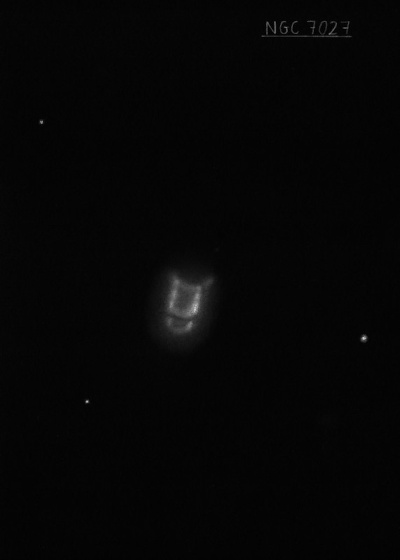
80mm (9/10/07): visible as a mag 8.5-9 "star" at 12.5x in the 80mm finder and easily identified using an OIII blink.
Édouard Stephan discovered NGC 7027 = St IX-27 in the fall of 1878 with the 31-inch Foucault reflector at Marseille. This planetary is probably the brightest object he discovered. From some reason it was not included in Esmiol's 1916 re-reduction of Stephan's positions.
The following observational history is from Wolfgang Steinicke. The Reverend Thomas Webb independently rediscovered NGC 7027 on 14 Nov 1879 using a 9-inch reflector. He described it as an "object like a bluish 9 mag star, not quite of stellar character - a small pair, too close to be separated?" At higher magnifications it was seen as "bright, very ill-defined, nebulous disk of about 4" diameter, surrounded probably by a little glow, and much resembling the planet Uranus." Webb's announcement in several publications created a flurry of interest in late 1879 with spectroscopic observations by Knott, Copeland, Winnecke, Vogel. In 1880, Dreyer noted Stephan's prior discovery, though it was still commonly assumed that Webb was the discoverer. E.E. Barnard observed NGC 7027 in June of 1889 with the Lick 36-inch at 500x (with Burnham) and logged, "In the p part there is a small bluish -green star like object - shining through ? haze. Occasionally a darkish space separates the condensations into two."
Based on Crossley photographs taken at Lick, Heber Curtis (1918) reported "the condensations are not stellar in the shortest exposures. Quite irregular and roughly trinuclear, though the southern condsation is apparently two masses close together. The southern condensation and the brighter at the north are 7.5" apart in p.a. 135°."
300/350mm - 13" (9/11/82): at 288x; small, bright, unusually high surface brightness, elongated NW-SE. There are two distinct overlapping nuclei and a narrow dark lane possibly separates these two condensations.
400/500mm - 17.5" (10/2/99): At 100x, the small greenish disc is very prominent but at higher powers appears bluish. Easily takes very high power and the view unfiltered at 380x and 500x was striking. Appears elongated 3:2 NW-SE, 0.3'x0.2', with two distinct lobes. The NW knot is slightly brighter and at times a stellar spot or star appears embedded at its SW tip. At 500x, the two knots are encased in a very small common halo that extends further out on the north side. The southern edge of both knots has a sharp, flat appearance.
900/1200mm - 48" (10/24/14): this fairly small, ultra-high surface brightness green planetary was observed at 610x. Overall, the object extends ~18"x12" NW-SE, but split up into three distinct components. The first and brightest component is an elongated glow (~10"x6" NW-SE) on the northwest side, which contains a very small, intensely bright knot at its western edge! The second bright component is adjacent to its east and is separated by a thin, darker lane. This section has an elongated, irregular outline (~10"x6" NW-SE), and is slightly mottled with brighter spots. A thin, high-contrast dark lane runs WSW-ENE at the south edge of these two sections. The third bright component, just southeast of this lane, appeared as an irregular, elongated bar, running 2:1 WSW-ENE, ~12"x6" and formed a "cap" on the southeast side. The two ends of this cap are very slightly curved (concave to the northwest).
Notes by Steve Gottlieb
IC 5117
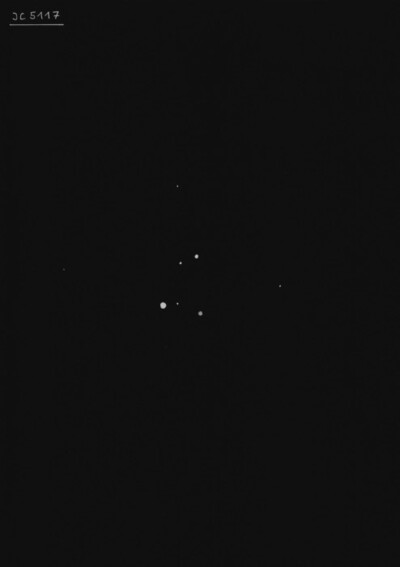
Williamina Fleming discovered IC 5117 = Fleming 104 in 1905 while classifying stars by examining photographic objective-prism spectra. A note in the 1905 Harvard College Observatory Circular No. 98 ("Stars Having Peculiar Spectra") simply mentions "this object is exceedingly faint." Thomas Espin made several visual observations in 1911 with his 17.25" reflector and the "nebula was thought to show a tiny disc."
Based on Crossley photographs taken at Lick, Heber Curtis (1918) reported IC 5117 was "indistinguishable from a star on the Crossley negatives, but shown to have a minute disk visually with the 36-inch refractor."
300/350mm - 13.1" (8/7/85): appears as mag 11.5 "star" without a filter. Forms a 20" double with a mag 10 star just east. Using an OIII filter the planetary is brighter than the star by one magnitude (contrast gain of roughly 2.5 magnitudes).
400/500mm - 18" (11/17/08): picked up at 175x in a rich star field by blinking with an OIII filter. Excellent contrast gain using the filter. Forms the fainter component (V = 11.5) of a "double star" with a mag 10 star 21" ENE, but with the filter the planetary dominates the star. Interestingly, there is similar double (Es 1339 = 10.8/11.5 at 24") in terms of separation and position angle ~3' NE! Without a filter at 175x, IC 5117 has a soft, bluish appearance. Using 450x, a very small 2" disc was clearly visible but it was too small to resolve any structure.
Notes by Steve Gottlieb
NGC 6833
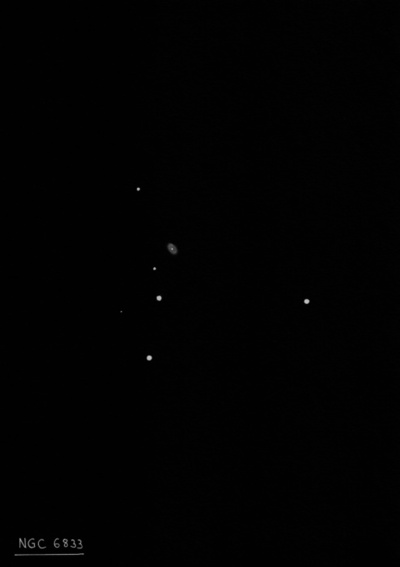
Edward Pickering discovered NGC 6833 = HN 54 on 8 May 1883 using a direct-vision prism with the 15-inch Merz refractor at Harvard College Observatory. His discovery position in AN 2517 was accurate.
Based on Crossley photographs at Lick, Curtis (1918) wrote "indistinguishable from a star on the Crossley negative, but shown to have a minute disk visually with the 36-inch refractor."
300/350mm - 13.1" (7/30/85): visible as mag 11.5-12 stellar object without a filter and verified with OIII blinking. A mag 10.5 star lies 2.8' NE and mag 9.0 SAO 48890 is 4.8' SE.
Notes by Steve Gottlieb
NGC 6881
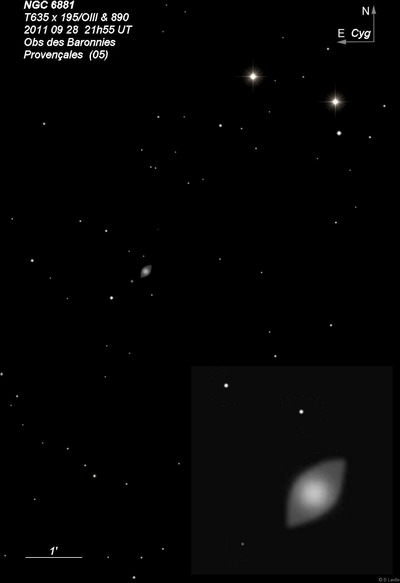
Edward Pickering discovered NGC 6881 = HN 44 on 25 Nov 1881 using a direct-vision spectroscope attached to the 15-inch refractor at Harvard College Observatory. His position in Sidereal Messenger, Vol 1, No 6 (Oct 1882) and The Observatory 1882 is accurate.
Based on Crossley photographs at Lick, Heber Curtis (1918) noted, "Probably has a central star. Just distinguishable from a star; a minute disk 5" in diameter, with very faint ansae in 150-330°."
300/350mm - 13.1" (8/7/85): visible as a mag 13.5 "star" without a filter. Verified with OIII blinking and appears brighter than a mag 12 just 44" SE. Stellar at 144x. Located in a rich Milky Way field. Several bright stars are near including mag 8.7 SAO 69561 3.6' NNW, mag 8.5 SAO 69557 4.2' NW and mag 9.5 SAO 69565 3.4' SSE.
Notes by Steve Gottlieb
NGC 7063
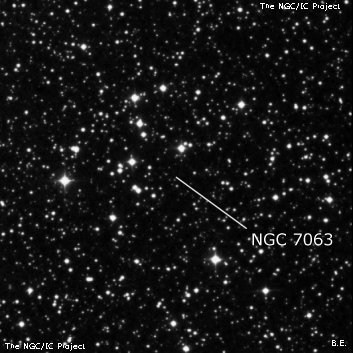
John Herschel discovered NGC 7063 = h2117 on 19 Aug 1828 and recorded "a poor cluster, stars 10m." His position matches this bright, scattered cluster.
400/500mm - 17.5" (8/7/91): about 35 stars mag 9-15 in a 10' region. Very bright, fairly large, elongated ~N-S. Includes about ten bright stars mag 9-10.5. This is a scattered group with no rich sections. A line of four bright stars is at the west edge and a curving arc of bright stars is just following. Includes a triple star (ES 2126) consisting of a close 4" well-matched mag 11 double star and a third member at 9".
Notes by Steve Gottlieb
NGC 6995
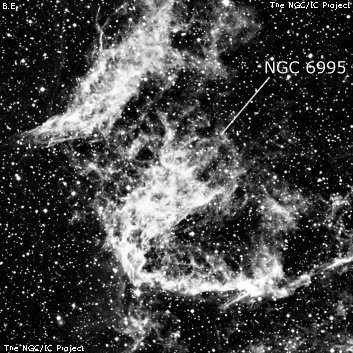
John Herschel discovered NGC 6995 = h2093 on 7 Sep 1825 (sweep 8) and recorded "A most wonderful phenomenon. A very large space 20' or 30' broad in PD and 1m or 2m in RA, full of nebula and stars mixed. The nebula is decidedly attached to the stars and is as decidedly not stellar. It forms irregular lace-work marked out by stars, but some parts decidedly nebulous, wherein no stars can be seen. A figure (from which the drawing for the engraving was copied), represents the general character, but not the minute details of this objects, which would be extremely difficult to give with any degree of fidelity." Ebenezer Mason was first to point out the Herschel's position was exactly 1° too far south based on Mason's careful observations and sketch (around 1838). Herschel's description and sketch clearly refer to the southern portion of the eastern half of the Veil Nebula. The northern half carries the number NGC 6992. This was only John Herschel's 6th overall discovery!
300/350mm - 13.1" (7/5/86): this is the amazingly detailed southern end of the eastern section of the Veil Nebula attached to NGC 6992 and contains beautiful feather-like side branches to the west, especially using an OIII filter. See description of NGC 6992.
400/500mm - 17.5" (7/5/86): feather-like side branches on the south end run off towards the west. Using an OIII filter at 83x, the breathtaking filamentary detail is too detailed to fully describe but the filaments appear like intertwined threads or twisted ropes giving a striking 3-dimensional appearance!
Notes by Steve Gottlieb
NGC 7082
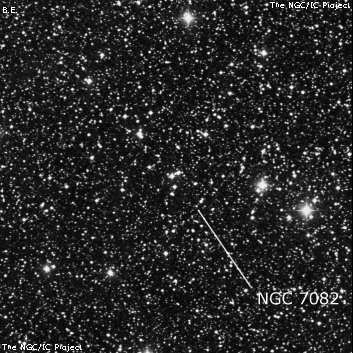
William Herschel discovered NGC 7082 = H VII-52 = h2122 on 19 Oct 1788 (sweep 868) and recorded "an extensive cluster of L stars, considerably rich, above 20' diameter." JH made the single observation "a * 10m, the chief of a p rich, fine, L, coarse cluster. Stars 10...13m."
400/500mm - 17.5" (9/7/91): fairly bright, large, 15' diameter, scattered, no distinct borders, situated in a very rich field. Two mag 8.5 star are on the west side, a mag 9 star is on the north side and also a mag 9 star is off the east edge. Not impressive and except for five or six brighter stars mag 8.5-9.5 at the edges this "cluster" would just be a weak field enhancement in the Milky Way.
Notes by Steve Gottlieb
IC 4996
William Herschel discovered IC 4996 on 20 Sep 1786 (sweep 594) and recorded, "Clustering stars the place taken is pretty much condensed, and contains 3 pS stars close together". He didn't assign an internal discovery number or H-designation, so this observation went unpublished, but Wolfgang Steinicke found that his offset in time and PD from 6th magnitude 34 Cygni (the next object in the sweep) matches this cluster. Steinicke also notes that soon after in the sweep he encountered M29, and just noted a "Clustering large stars" again without assigning a number.
According to Steinicke, Hugo Clemens "noticed the object on a plate taken [13 Jun 1896] for the Photographische Himmelskarte with a 10.5" f/10.5 astrograph at Potsdam Observatory." The IC credit went to Frank Bellamy, who independently discovered IC 4996 on a plate taken 13 Jun 1896 with the 13" astrograph at Radcliff Observatory in Oxford. The discovery was announced in the paper "A New Cluster in Cygnus", MNRAS 64, 662 (1904). Bellamy didn't state a position for the cluster and Dreyer's estimated position is ~25' too far north.
200/250mm - 8" (8/28/81): consists of three mag 9 stars with a string of stars to the stars, over haze, appears rich with averted.
300/350mm - 13.1" (8/25/84): ~40 stars at 144x. Rich in faint stars using averted vision.
13.1" (9/9/83): 30-40 stars at 160x, appears very rich, includes several very faint stars, elongated SSW-NNE. The brightest stars are three mag 8.5-9 stars in a tight grouping in the center.
400/500mm - 18" (8/14/04): beautiful open cluster at 225x with perhaps three dozen stars resolved in fairly poor seeing. Appears small, but rich and quite elongated SSW-NNE, ~4'x2'. Includes three bright mag 8.5-9.5 stars (ADS 13626) forming an obtuse isosceles triangle with the brightest star at the vertex. A 4th fainter star to the west forms a trapezoid with this trio. Two of the stars in the triangle are close, unequal doubles (including ß422, 9.7/10.8 at 4") and the single star has a 13th magnitude close pair nearby! The remainder of the stars in the cluster are generally mag 13 and fainter. There are sprays of stars to the north and south giving the elongated appearance. Located 1.1° SE of the Crescent Nebula and 1.7° SW of M29.
Notes by Steve Gottlieb
NGC 7039
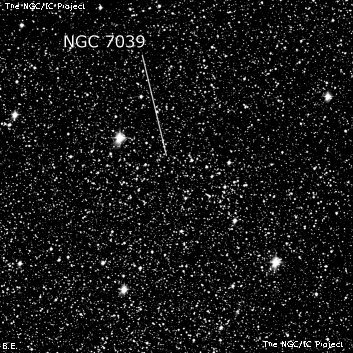
John Herschel discovered NGC 7039 = h2107 on 19 Sep 1829 and recorded "a star 6-7m situated just beyond the nf edge of a L, p rich cluster, 11...15m, 20' long, 7' broad. Extended from nf to sp." His position matches mag 6.7 HD 201935 on the northeast side of the cluster.
400/500mm - 17.5" (9/7/91): about 125 stars in a 15'-20' diameter. This is a very large, rich triangular group. Two bright mag 7.5 stars are at the SSW and NNE ends. Also two mag 9 stars are involved. Very rich in mag 12-13 stars. This is a pretty uniform cluster with a sprinkling of brighter stars. Excellent low power Milky Way field using a 20mm Nagler.
Notes by Steve Gottlieb
NGC 6883
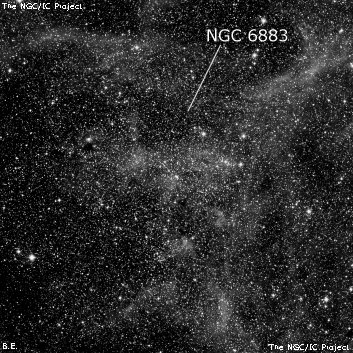
John Herschel discovered NGC 6883 = h2070 on 19 Aug 1828 NGC 6883 and recorded "a double star in a cluster of a good many stars 10...13m." Dreyer, the observing assistant at Birr Castle on 23 Aug 1876, simply noted "rich field, no remarkable cluster."
200/250mm - 8" (8/15/82): elongated string of stars N-S, moderately large, over background haze. Situated in a very rich star field and difficult to identify.
400/500mm - 17.5" (8/19/95): two dozen stars in a 4' diameter surrounding a prominent "Y" asterism of five mag 10 stars with twenty additional mag 13-14.5 stars. The brightest star at the base of the "Y" is a mag 9.5/10 double at 17" and the center star about 1.5' NE is an unequal closer pair. Surrounding this group is a oval border of 7' diameter consisting of several strings of mag 13 stars, which increase the total to roughly 50 stars. Appears to be an asterism in a rich Milky Way field and best view at 100x. Attached to Ruprecht 172.
Notes by Steve Gottlieb
IC 5070
Reverend Thomas Espin discovered IC 5070, along with IC 5068, visually on 7 Sep 1899 with a 17 1/4-inch reflector at his Tow Law observatory in England. The discovery was included in a short list of 6 new objects (including the Cocoon Nebula) in AN 3633 and noted as "faint and diffused". His position corresponds with the "neck" of the Pelican, the brightest part of the nebula, so the identification is certain.
Max Wolf photographed the region surrounding the North American Nebula on 1 Jun 1891 (AN 3048) on a 3 hour plate. He gives a general description of the region with no specific positions, though mentions strong nebulosity was recorded around the stars 56 and 57 Cygni, which are involved in the Pelican Nebula. So, certainly it was captured on his early image. Espin is credited with the discovery in the IC2, but Wolf should share credit.
200/250mm - 8" (6/22/81): faint, surrounding scattered group of stars at 50x and UHC filter. Appears as a bright patch to the west of two bright stars (neck section).
300/350mm - 13.1" (7/5/83): the entire body of the "Pelican" is easily visible at 62x and a UHC filter. The "head and neck" section is easy to view along with the fainter "bill" and a long body extending from head. Located west of the North America Nebula in a rich field between two mag 7 stars.
400/500mm - 18" (7/17/07): The huge Pelican Nebula overfilled the 67' field in the 31 Nagler. The UHC filter gave a higher contrast than the OIII filter. Several brighter sections were noted on the close-up chart A1 in the U2000 atlas. One of the brightest pieces is the "neck" of the Pelican located 20'-25' W of mag 4.8 57 Cygni and collinear with two mag 8/9 stars 10' and 12' due west. The glow extends 10' in length. To the SW of the mag 4.8 star is the large "beak" section that streams from NW to SE and extends roughly 20'x8', widening a bit at the SE end. The west side of the beak is defined by a dark lane that parallels the nebulosity and the large, faint body of the Pelican is west of this lane and includes 5.1-magnitude 56 Cygni (the nebulosity is very weak here). The brightest section of the body is a large, circular patch at the south end, ~12' diameter, and located 30' SE of 56 Cygni and 55' S of the "neck".
18" (9/25/06): This was the first observation of the Pelican Nebula in quite awhile and I forgot about this huge, interesting emission nebula. The view was fascinating at 113x with an OIII or UHC filter as this object overfilled the 44' field. I started exploring to the west of 4.8-magnitude 57 Cygni. The brightest section is possibly on a line with this star and a mag 7.2 star further east and corresponds with the neck portion on the Pelican. This is where the ionization front is most evident on photographs. The elongated "beak" of the Pelican also begins to the west of the bright star and streams off in a wide river of nebulosity towards the southeast and passing out of the field. A long darker lane apparently free of nebulosity isolates the "neck" from the main body of the Pelican. The irregular body spreads out to the south of the neck well beyond the southern edge of the eyepiece field and extends at least 65' from the neck terminating at the SE end with a roundish bright patch of nebulosity ~12' in diameter. The Pelican is located directly west of the North American Nebula and part of the same huge complex of nebulosity in this region (separated by the dark cloud LDN 935).
Notes by Steve Gottlieb
NGC 7062
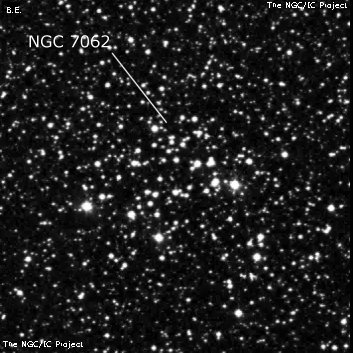
William Herschel discovered NGC 7062 = H VII-51 = h2116 on 19 Oct 1788 (sweep 868) and recorded "a pretty compressed cl. of pS stars, considerably rich, 5 or 6' dia, iR." JH made 3 observations, first recording (sweep 203), "a neat, pretty compact cluster of 50 or 60 stars 4' diam; irreg fig; a * 13m taken, the chief in the preceding part."
200/250mm - 8" (7/16/82): rich, small. Includes many mag 12-13 stars over haze, very mottled and dense.
400/500mm - 17.5" (8/7/91): about 30 stars mag 10 and fainter in a 5' diameter at 220x. The brightest stars form a parallelogram enclosing the cluster. A mag 10 star is at the east end and a mag 11 star is at the west end. Most of the cluster stars in the interior are mag 12.5-14.
Notes by Steve Gottlieb
IC 1369
Carl Frederick Pechüle discovered IC 1369 on 27 Apr 1891 using the 11-inch refractor at the Copenhagen Observatory (1894AN....136..317P). Rev. Thomas Espin independently discovered the cluster on 9 Sep 1893 with his 17.5-inch reflector in England and recorded "Faint, large, many small stars."
200/250mm - 8" (8/12/83): rich glowing spot with many very faint stars at visual threshold over haze with averted. Also a small group of five stars in the field to the E. A wide pair ß159 = 6.0/7.5 at 135" is in the field 18' WSW.
300/350mm - 13.1" (9/3/83): 15 faint stars over haze, fairly small, appears rich.
400/500mm - 18" (7/30/03): this fairly rich open cluster was picked up while observing dark nebula B361 located 20' S. At 215x, approximately two dozen stars were resolved in a boxy outline, roughly 4' diameter. There is a lower density of stars in the center of the group and the cluster is set over some unresolved haze. Appears as a partially resolved glowing spot at 73x (31 Nagler). Sh 1-89, a faint planetary, lies 20' E.
Notes by Steve Gottlieb
NGC 7031
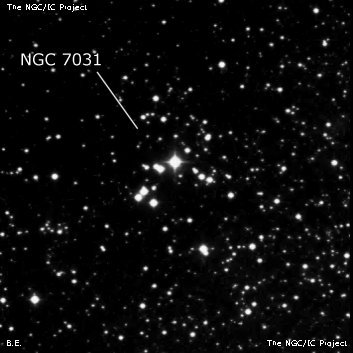
William Herschel discovered NGC 7031 = H VIII-74 = h2105 on 21 Sep 1788 (sweep 860) and recorded "a coarsely sc cl of L stars, not very rich, about 5 or 6' diam." JH made the single observation "a curious scattered cluster of triple stars; RA taken from the working list [of Caroline Herschel]."
400/500mm - 17.5" (8/10/91): at 220x, about two dozen stars mag 11-15 in a 6' diameter. At the east edge is close double star 11.4/11.8 with a third mag 11.5 star close SW. A nice string of stars is along the north side extending NW from the trio including a close double star 12/13 1' N. A mag 11 star is on south side but the rest of the stars are mag 13-15. Not very rich but stands out in a rich field. The cluster is fairly scattered except for this region with brighter stars. At 410x, I used the sequence of magnitudes in Clark's Visual Astronomy to positively identify a faint V = 16.1 star and suspected a V = 16.3 star.
Notes by Steve Gottlieb
NGC 7067
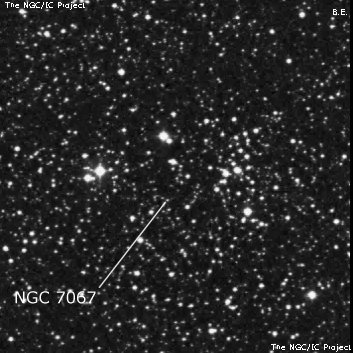
William Herschel discovered NGC 7067 = H VII-50 = h2118 on 27 Sep 1788 (sweep 866) and recorded "a few small stars with suspected nebulosity. 300 shows a great many smaller stars intermixed with the former, in the shape of a cluster." Although not visually distinctive, his position matches this small cluster. JH made the single observation "A double star. The chief of a poor cl." His position matches HJ 1644 (SAO 5080), which is 4' east of the faint but rich section. Perhaps he failed to resolve these stars?
400/500mm - 17.5" (8/10/91): about 20 stars in a 3' field. Faint but fairly rich, most stars very faint. Superimposed over unresolved background haze. The two brightest mag 12 stars are at the SW and NE corners. A rich string of very faint mag 14-15 stars oriented NW-SE is in the center as well as two mag 13 stars.
Notes by Steve Gottlieb
NGC 7128
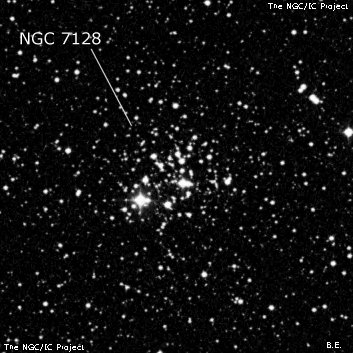
William Herschel discovered NGC 7128 = H VII-40 = h2130 on 14 Oct 1787 (sweep 765) and recorded "a cl of small stars of several sizes, 3 or 4' in diam, pretty rich but like a forming one." JH made the single observation "a star 9-10m of a ruby red color in an oval annulus of small stars, 4' diam."
200/250mm - 8" (10/13/81): 15 faint stars, small, rich, over background haze, two mag 11 stars are at the south edge.
400/500mm - 17.5" (9/7/91): 22 stars mag 11-13 in rich and compact 2.5' region. Most stars are arranged in oval ring NW-SE. A mag 11.5 star at the east edge has several very faint companions. Two mag 11 stars are on the south side. A double star mag 12/12 is on the west side as well as a few other double stars. A string of stars oriented SW-NE is just NW of the oval ring.
Notes by Steve Gottlieb
NGC 6764
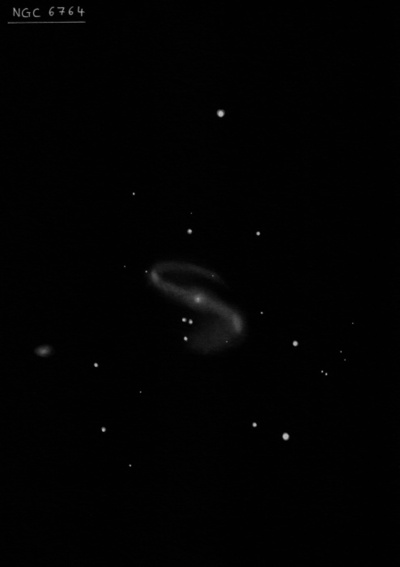
Lewis Swift discovered NGC 6764 = Sw. II-77 on 4 Jul 1885 and recorded "pF; pL; cE; sev vF stars involved." His position is on the west side of UGC 11407 and the involved stars are on the south side of the galaxy. Herbert Howe, observing with the 20-inch refractor in Denver in 1899-00, commented "the elongation is north and south. Four stars of mag 13.5 are involved, one near each end, and the others in the middle." Howe's description seems inaccurate.
300/350mm - 13.1" (10/20/84): fairly faint, diffuse, fairly small, slightly elongated WSW-ENE, very diffuse edges. Two or three faint stars are superimposed on the halo south of center although one of these may be a faint stellar nucleus. A nice double star is 6' WNW (mag 11/12 at 20"). Located on the Cygnus-Draco border.
600/800mm - 24" (6/29/16): at 260x; moderately bright, very elongated 5:1 WSW-ENE (central bar), ~1.7'x 0.35', broad weak concentration, sharp stellar nucleus. After careful viewing, a very low surface brightness halo surrounds the bar, which increased the size to ~1.7'x0.6'. Three mag 14-15 stars are at the south side including a 10" pair parallel to the major axis [25" south of the nucleus]. A faint non-stellar knot was visible at the ENE end of the bar. Occasionally it was elongated and angled towards the north. A matching knot was suspected (lower contrast) at the WSW end of the bar.
Forms a pair with LEDA 214715 2.7' ESE. At 260x, the companion appeared faint to fairly faint, small, slightly elongated E-W, 20"x16" or perhaps 15"x12", weak concentration, slightly brighter nucleus. Visible continuously at this magnification.
Notes by Steve Gottlieb
UGC 11465
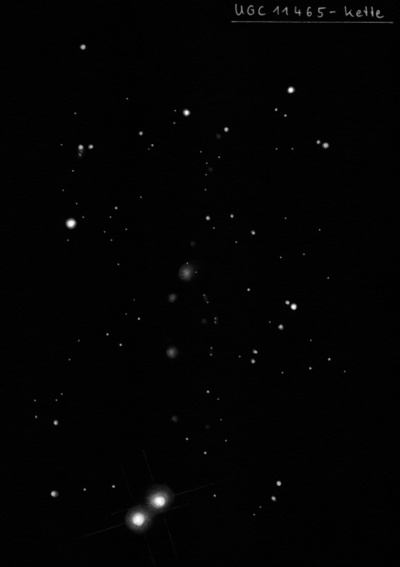
400/500mm - 17.5" (9/23/00): At 280x, fairly faint but relatively bright for a UGC galaxy. Appeared fairly small, round, 35" diameter. Even concentration with a relatively large brighter core increasing to a stellar nucleus. Forms an easy pair with MCG +08-36-003 ~2' SSE just 7' N of 16 Cygni.
17.5" (6/28/00): fairly faint, small, round, 25" diameter, weak even concentration to a very small brighter core. Brightest of close trio with MCG +8-36-3 2.3' SSE and PGC 63532 just 0.8' SSE. In the same high power field with the bright double star 16 Cygni!
17.5" (8/13/88): fairly faint, fairly small, round, small bright core. Located 7' N of the striking double star 16 Cygni = 6.3/6.4 at 39". Forms a pair with MCG +08-36-003 2.3' SSE.
600/800mm - 24" (7/10/18): at 375x; fairly faint to moderately bright, fairly small, round, well concentrated with a bright core that gradually increased to the center. UGC 11465 is situated in a rich Cygnus star field with CGCG 257-007 2.3' SSE, PGC 63531 just off the southeast side [50" from center] and PGC 63532 just off the NNE edge [38" from center] . Located 7' N of the wide, bright double 16 Cygni! UGC 11465 and CGCG 257-007 form a double radio source (3C 402). PGC 63531 appeared faint, extremely small, round, 10" diameter (375x). PGC 63532 only occasionally popped as extremely faint and small (500x).
Notes by Steve Gottlieb
UGC 11798
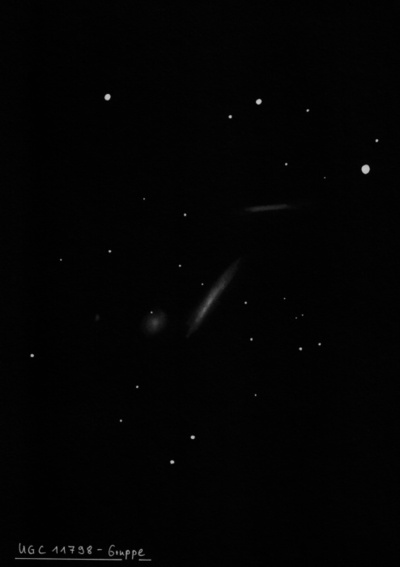
600/800mm - 24" (7/14/18): at 375x; faint, moderately large, very elongated 7:2 NW-SE, 0.8'x0.25', low nearly even surface brightness. Second in an unusual triplet of low surface brightness galaxies in a rich galaxy field 3.7' SE of a mag 8.5 star.
24" (8/31/16): at 322x; fairly faint, moderately large, very elongated 4:1 NW-SE, 1.0'x0.25', broad weak concentration. Slightly larger than UGC 11797 1.8' NW. Second in a triplet with UGC 11801 1.2' ESE.
24" (8/5/13): faint to fairly faint, moderately large, very elongated 4:1 NW-SE, 0.8'x0.2', slightly brighter nucleus. Forms a very close pair with UGC 11801 just 1.2' ESE with UGC 11797 1.8' NW.
24" (9/13/12): faint to fairly faint, moderately large, very elongated 4:1 or 5:1 NW-SE, ~1.0'x0.2'. In a tight trio with UGC 11801 1.2' E and UGC 11797 1.7' NW. Located 3.7' SE of mag 8.5 SAO 51224 in a rich Cygnus star field.
Notes by Steve Gottlieb
IC 5076
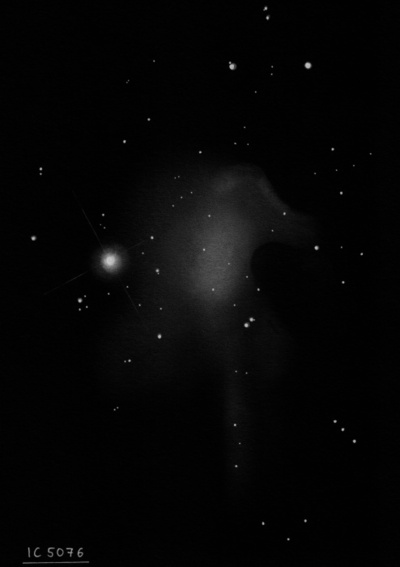
Isaac Roberts discovered IC 5076 on 13 Sep 1895 while taking a photograph of the "cluster" NGC 6991. The discovery was announced in MNRAS, 56, 33 (1895). He noted "it is about 6 1/2 minutes of arc in length from north to south, and 5 minutes of arc in breath from preceding to following, irregular in outline and with many stars, both bright and faint, involved or in alignment with it. The nebulosity has no regular structure and is of a fleecy character, the margins gradually fading into invisibility."
200/250mm - 8" (8/28/81): mag 6 star surrounded by very faint reflection nebula at low power using a Daystar 300 filter.
300/350mm - 13.1" (8/25/84): fairly faint, extends generally west of the mag 5.7 star although the border is irregular.
400/500mm - 17.5" (10/24/92): fairly faint, fairly large, 4' diameter. Extends west of mag 5.7 SAO 50246. The vicinity is fairly rich in arcs of stars. The nebulosity is on the west side of a striking 5' group of stars that are centered on the bright star. Ten of the stars surrounding the mag 5.7 star form a semi-circle including a tight quadruple 2' SE. A scattered group of stars (h2091 = NGC 6991) is 10' WSW.
Notes by Steve Gottlieb
IC 1340
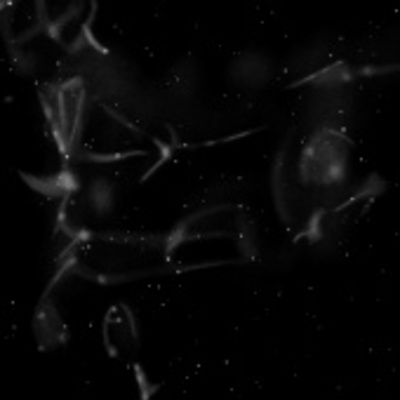
Truman Safford discovered IC 1340 = Sf. 51 on 13 Sep 1866 with the 18.5-inch refractor at the Dearborn Observatory. He noted "possibly connected with h2093 [NGC 6995]." His position is ~1.5' northeast of this knot in[NGC 6995.
400/500mm - 17.5" this is part of the intricate southern portion of the eastern arc (NGC 6992) of the Veil nebula. This region contains the remarkable filamentary side branches that extend west at the south end of(NGC 6992 and NGC 6995. See description for(NGC 6992.
Notes by Steve Gottlieb
NGC 6766
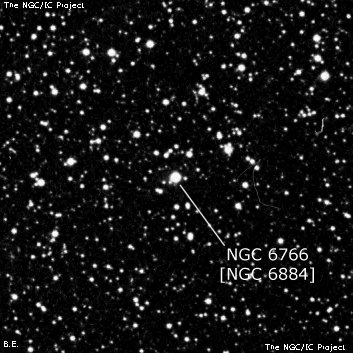
Ralph Copeland found NGC 6884 on 20 Sep 1884 at Dun Echt, Aberdeen, using an objective-prism sweep with a 6.1-inch refractor. He remarked "planetary nebula; most of the light in a single line" and measured a very accurate micrometric position (MN XLV).
Edward Pickering discovered this planetary earlier on 8 May 1883 using a direct-vision spectroscope (same technique) at Harvard College Observatory. Unfortunately, Pickering made a 1 hr error in RA (later corrected), so Dreyer catalogued it as NGC 6766 at the wrong position and this number is usually considered nonexistent. By historical precedence, this planetary should be called NGC 6766, but it is now known as NGC 6884.
Based on Crossley photographs at Lick, Heber Curtis (1918) noted "no central star can be distinguished. A minute, bright, round disk, of nearly equal brightness throughout, with a suggestion of an elongated brighter central portion in p.a. 135°; 7.5" in diameter in a 5 min exposure."
300/350mm - 13.1" (9/29/84): fairly bright, very small, high surface brightness, definite bluish disk at 166x, excellent contrast gain with OIII filter. Easily takes 350x due to surface brightness.
400/500mm - 17.5" (9/7/91): bright, very small, very high surface brightness. Appears as a slightly out of focus mag 11 bluish star at 100x. Moderate contrast gain using an OIII filter. At 412x appears prominent with a very small 5" blue disk.
Notes by Steve Gottlieb
M 1-92
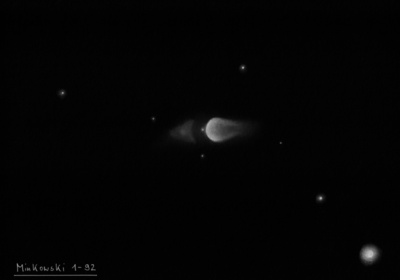
| Type | BN [R] |
| RA | 19:36:18.9 |
| Dec | +29:32:50.0 |
| major_axis | 18.0'' |
| minor_axis | 12.0'' |
| mag | 11.7 |
| surface_bright | 7.3 |
Hu 1-2
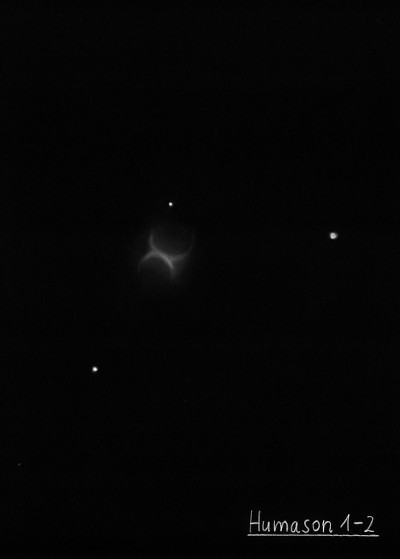
| Type | PN |
| RA | 21:33:08.3 |
| Dec | +39:38:10.0 |
| major_axis | 30.0'' |
| minor_axis | 18.0'' |
| position_angle | 3.0 |
| mag | 12.7 |
| surface_bright | 10.6 |
M 1-79
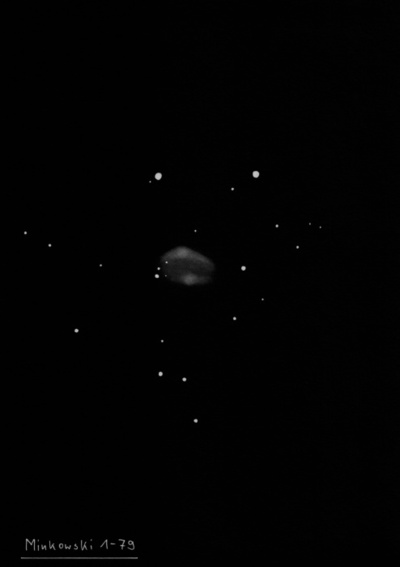
| Type | PN |
| RA | 21:37:01.5 |
| Dec | +48:56:03.0 |
| major_axis | 36.0'' |
| minor_axis | 30.0'' |
| mag | 13.2 |
| surface_bright | 11.6 |
Hen 1-4
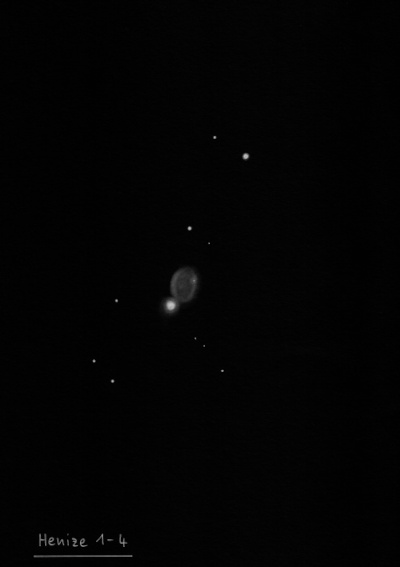
| Type | PN [3b] |
| RA | 19:59:18.0 |
| Dec | +31:54:39.0 |
| major_axis | 24.0'' |
| mag | 14.1 |
| surface_bright | 11.6 |
Abell 61
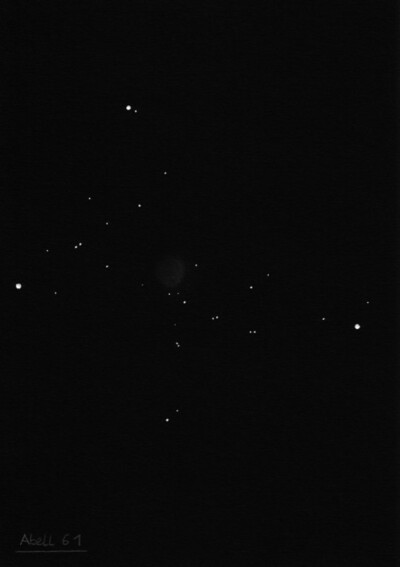
| Type | PN [2b] |
| RA | 19:19:10.2 |
| Dec | +46:14:52.0 |
| major_axis | 3.2' |
| mag | 14.4 |
| surface_bright | 16.7 |
M 4-17
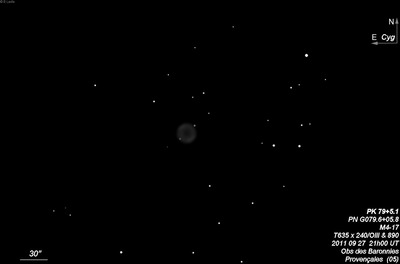
| Type | PN [4(2)] |
| RA | 20:09:01.9 |
| Dec | +43:43:44.0 |
| major_axis | 24.0'' |
| minor_axis | 18.0'' |
| position_angle | 5.0 |
| mag | 14.5 |
| surface_bright | 12.0 |
Abell 71
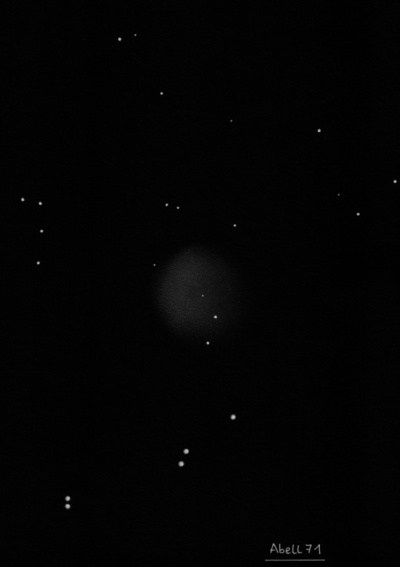
| Type | PN [3b] |
| RA | 20:32:23.2 |
| Dec | +47:20:50.0 |
| major_axis | 2.6' |
| mag | 15.2 |
| surface_bright | 17.0 |
Abell 78
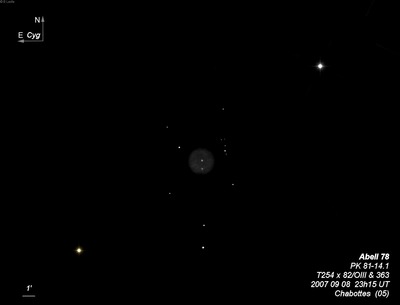
| Type | PN |
| RA | 21:35:29.4 |
| Dec | +31:41:45.0 |
| major_axis | 2.0' |
| minor_axis | 1.7' |
| mag | 16.0 |
| surface_bright | 17.1 |
K 3-82
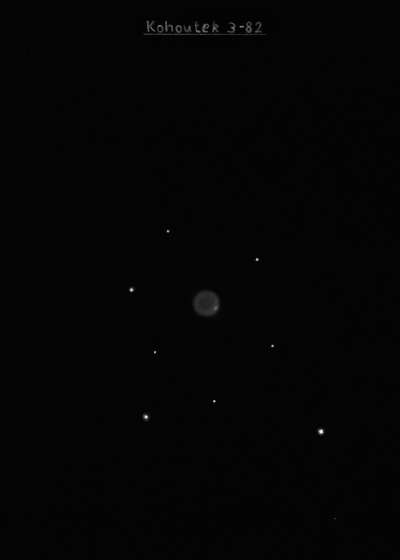
| Type | PN |
| RA | 21:30:51.5 |
| Dec | +50:00:08.0 |
| major_axis | 24.0'' |
| mag | 16.0 |
| surface_bright | 13.7 |
M 1-75
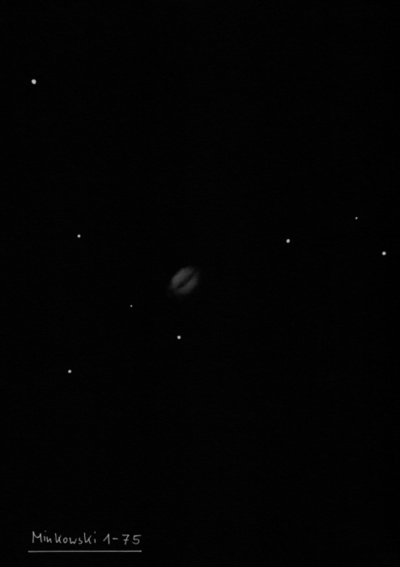
| Type | PN [3b(6)] |
| RA | 20:04:44.1 |
| Dec | +31:27:28.0 |
| major_axis | 42.0'' |
| mag | 16.0 |
| surface_bright | 15.0 |
K 3-73
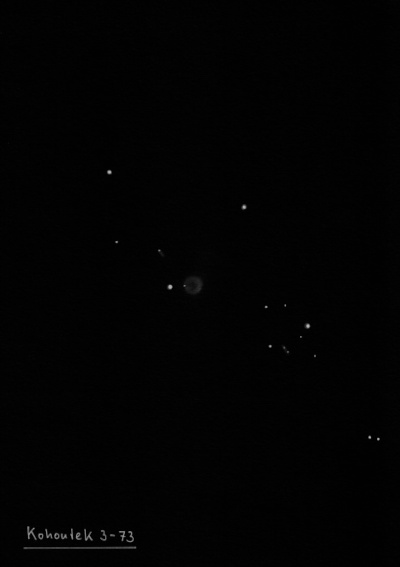
| Type | PN |
| RA | 20:04:00.0 |
| Dec | +49:19:06.0 |
| major_axis | 18.0'' |
| mag | 16.1 |
| surface_bright | 13.4 |
K 3-46
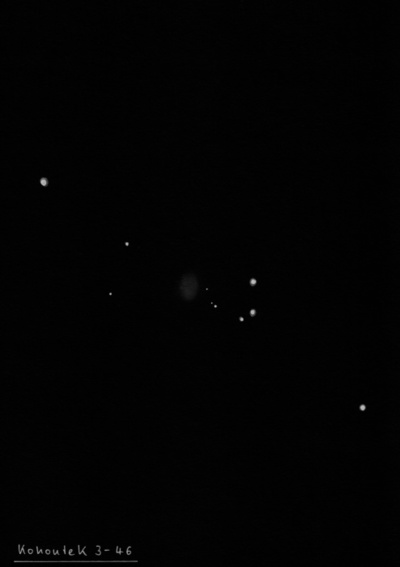
| Type | PN [3b(6)] |
| RA | 19:50:00.3 |
| Dec | +33:45:52.0 |
| major_axis | 30.0'' |
| minor_axis | 18.0'' |
| mag | 16.4 |
| surface_bright | 14.0 |
Abell 69
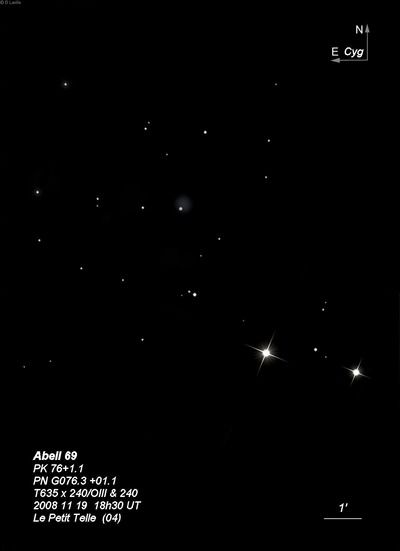
| Type | PN |
| RA | 20:19:58.3 |
| Dec | +38:24:02.0 |
| major_axis | 24.0'' |
| minor_axis | 18.0'' |
| position_angle | 3.0 |
| mag | 20.1 |
| surface_bright | 17.6 |
